Smart Motorway on China-Pakistan Economic Corridor (CPEC) Road Network Project
Info: 27682 words (111 pages) Dissertation
Published: 9th Dec 2019
FEASIBILITY AND PROCUREMENT OF SMART MOTORWAY ON CHINA-PAKISTAN ECONOMIC CORRIDOR (CPEC) ROAD NETWORK PROJECT
Table of Contents
Environmental Assessment of Building and Highway
Generic Internal Organisational Factors
The organisational system factor
External organisational factors
What is China- Pakistan Economic Corridor?
China-Pakistan Economic corridor routes
1. Identify Risk (Risk Register)
2. Probability and Impact Assessment
3. Plan Risk Responses (Strategies for Risks)
4. Alternative Approaches of Risk Management
Contracting and procurement strategy
Controlled motorway, Hard shoulder and All Lane Running
What type of technology is procured and why?
Pilot Project for smart motorway
Coordination within construction projects
Development of Infrastructure:
Improved socio-economic status:
Natural disaster and hazardous effect:
TABLE OF FIGURES
Figure 1 Collaboration Adapted from Hannman and Lee (1995, p113)
Figure 2 Sustainable Supply Chain Strategies Adapted from Richard Mathews (2011)
Figure 3 Smart Motorway Mechanism Adapted from Vinci (2015)
Figure 4 Triple Bottom Line Effect Adapted from Tanya and Timothy (2011)
Figure 5 CPEC Railway Connectivity Adapted from Tribune (2015)
Figure 6 One Belt One Route Initiative Adapted from GIS report (2017)
Figure 7 Eastern Route Adapted from Tribune (2015)
Figure 8 Western Route Adapted from Tribune (2015)
Figure 9 Internet of Things Adapted from Highway England (2015)
Figure 10 Institutional Framework Adapted from cpec.gov.pk
Figure 11 Smart Motorway Regulation Adapted from Designing Building (2017)
Figure 12 CPEC Route Adapted from cpec bulletin (2017)
Figure 13 Pilot Area Adapted from EIA (2014)
TABLE OF TABLES
Table 1 The Result analysis and discussion approach
Table 2 Research Method used for dissertation
Table 4 Probability Impact Matrix
Table 5 Risk Response Strategies (Threats)
Table 6 Risk Response Planning (Opportunities)
Table 8 Current Institutional Framework
Table 9 Recommended Changes to Institutional Framework
Table 10 Recommended Procurement Strategy
Table 11 Triple Bottom Effect of Smart Motorway on CPEC
Table 12 Networked Readiness Index of Smart Motorway on CPEC
Abbreviations
| SSCM | Sustainable Supply Chain Management |
| SCM | Supply Chain Management |
| CPEC | China Pakistan Economic Corridor |
| CSR | Corporate Social Responsibility |
| CoQ | Cost of Quality |
| BREEAM | British Research Establishment Environmental Assessment Method |
| LEED | Leadership in Energy and Environmental Design |
| OM | Operations Management |
| OBOR | One Belt One Route |
| ATM | Active Traffic Management |
| HSM | Hard Shoulder Management |
| GIS | Geographic Information System |
| JWG | Joint Working Group |
| NHA | National Highway Authority |
| CSCEC | China State Construction and Engineering Corporation |
| JCC | Joint Co-operation Committee |
| MoPDR | Ministry of Planning, Development and Reforms |
| NDCR | National Development and Reform Commission |
| GOP | Government of Pakistan |
| GOC | Government of China |
| MoC | Ministry of Communication |
| CCCC | China Community and Construction Company |
| LG | Local Government |
| LB | Local Business |
| NGO | Non-Governmental Organisation |
| MoF | Ministry of Finance |
| MoIT | Ministry of Information Technology |
| MoED | Ministry of Environment and Development |
| MoEPD | Ministry of Energy/ Power Division |
| GDP | Gross Domenstic Product |
| CCTV | Closed Circuit Television |
| FEED | Front End Engineering Design |
| MIDAS | Motorway Incident Detection Automatic Signal |
| KPK | Khyber Pakhtun Khwa |
| KPI | Key Performance Indicator |
A feasibility study of Smart Motorway on an ongoing project known as China-Pakistan Economic Corridor (CPEC) is the purpose of the dissertation. China have an initiative to develop and connect the Asia and Europe through road and railway network. This initiative is called One Belt One Route (OBOR) and CPEC is a part of this initiative. There is Eastern and Western route connecting Pakistan and China with several other power and developmental project. Dissertation is on the procurement strategy, institutional framework required and the risk involved in having a smart motorway for sustainable operation mechanism of traffic flow on CPEC road network construction project. Based on the responses from the questionnaire for this quantitative research a PILOT project have also been proposed for the smart motorway on CPEC. Smart Motorway uses the Internet of Things system for Active Traffic Management to allow for a smooth flow. As the current road infrastructure does not have the capacity to support the growing vehicle usage and the vision of trade relation behind the CPEC, thus smart motorway is a long term oriented approach to develop and use the highway to facilitate the capacity of vehicle usage that is projected for the foreseeable future.
Introduction
The corporate goals of an organization may include faster delivery, good quality, customer service, supplier management. Transportations and logistics are one of the important parts of the supply chain management, which calls out for a good infrastructure in place for the road, rail and air transportation (Rushton, Croucher, & Baker, 2010). Roads are the medium of transport most widely used all around the world both nationally and internationally (Abid & Ashfaq, 2015). Construction work is a major component of all infrastructure and industrial development, such as buildings, highways, airports, railroads, hospitals, schools, housing, dams, irrigation systems, etc. With increasing growth in the construction industry, the construction business has become a competitive environment in recent years. To keep up with this competitive challenge, organisations throughout the world employ many factors, such as public-sector awards, profits derived from changes instead of sticking to the initial bid, access to state-subsidised financing, and preference for constructors who employ unionised workers, among others. According to (Jafari & Rodchua, 2014) one of the main factors for firms to consider in such a competitive environment is the need to strike a balance between the level of end-product quality and concomitant expenses. The increasing costs of material supplies and wages greatly impact construction activity costs, thus raising expenditures for businesses and organisations.
China and Pakistan have agreed to build One Belt One Road project more commonly known as China-Pakistan Economic Corridor. This corridor will incorporate 2,000km transport link between Pakistan and China (Abid & Ashfaq, 2015). The research is to analyse the operation management techniques of the smart motorway in the most congested areas throughout the route where the use of Heavy weight vehicles and light weight vehicles is relatively more than the usual like metropolitan areas as Gwadar, Quetta, Peshawar, Karachi, Hyderabad, Faisalabad, Lahore and Islamabad. There is a need for global sustainability because of the environmental impacts that the developmental infrastructure have. Adopting the practices of sustainable development that have been defined by commission of (Brundtland, 1987), as a practice that meets the present need without compromising the need of the future generations.
Keeping view of sustainability and need for highways that are required for long terms and upcoming generations as the highways have become a necessity for now a day especially for the use of the logistics companies that are involved in the third-party logistics (3PL) and four party logistics (4PL), the need for the customer demands for having good quality products on time and at the right place at the right price as described by (Rushton et al., 2010). Also, the need for the customers to travel between different areas either for research, site visits, vacations and the impotency that has now been developed because of the fast-paced world. This all need a sustainable operation mechanism for the physical goods, human and capital machinery transit, as well as to provide a fast effective and efficient world class transport services. Road is one way of the transit and the congestions of the highway leads to an intolerable problem in many urban areas.
One approach to deal with such a problem is to either develop more road networks and highways, levying more taxes and tolls to reduce demand and congestion, which might not be a feasible option. The second option is to sustain and develop an operation mechanism by implementing the range of driving functions that should be automated, the extent of automation and the breakdown of these functions into control tasks (Hsu, Eskafi, Sachs, & Varaiya, 1993). This will lead in achieving the Sustainable Supply Chain Management (SSCM) as transport is one of the major part of supply chain. That is why creating a better operation mechanism and better road transport for the benefits of the general users and for the corporate and trade purpose will help in achieving the SSCM which is described by (Pagell & Wu, 2009) as:
“To be truly sustainable a supply chain would at worst do no net harm to natural or social systems while still producing a profit over an extended period of time; a truly sustainable supply chain could, customers willing, continue to do business forever“ (Pagell and Wu, 2009: 38).
What is China- Pakistan Economic Corridor?
According to the Government of Pakistan the definition of CPEC is
“China-Pakistan Economic Corridor is a framework of regional connectivity. CPEC will not only benefit China and Pakistan but will have positive impact on Iran, Afghanistan, India, Central Asian Republic, and the region. The enhancement of geographical linkages having improved road, rail and air transportation system with frequent and free exchanges of growth and people to people contact, enhancing understanding through academic, cultural and regional knowledge and culture, activity of higher volume of flow of trade and businesses, producing and moving energy to have more optimal businesses and enhancement of co-operation by win-win model will result in well connected, integrated region of shared destiny, harmony and development.”
The project of the China-Pakistan Economic Corridor (CPEC) involves the development of the deep-sea Gwadar Port towards the South of Pakistan, then the route from the deep-sea port will be linked to the far west of the Chinese city of Kashgar, which is towards the south of China. The route to Gwadar Port will be providing China an access to the Arabian Sea port, an alternative to the current long sea route for the trade purpose that is being used by China. China will also have an opportunity to develop its largest and poorest regions, Xinjiang. Xinjiang has been experiencing terrorism and ethnic unrest for a long time, in the Uighur Muslim community (Martina, 2013). Figure 1 below shows a sketch of the original CPEC route that will connect Pakistan from China.
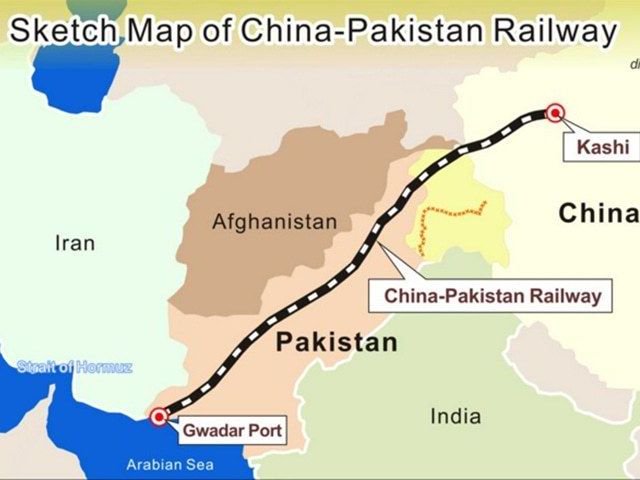
Figure 1 CPEC Railway Connectivity Adapted from Tribune (2015)
Pakistan will have the opportunity to get benefit from CPEC with the view to replenish its economy, fix the energy shortages because of several renewable and coal power projects to take place as the part of the CPEC project and most importantly, address the security issues and make a statement to the world who perceive Pakistan as a non-secure and terrorist nation. CPEC also involves project of facilitate railways, highways, airports, and metros throughout Pakistan (Paskistan Today, Pakistan Ministry of Planning, Development & Reform ,2018).The disturbing energy shortages stifling the economic productivity will be resolved through the addition of wind, solar, nuclear, and coal power projects (Malik, 2012). Improvement of road infrastructure and economic development of Pakistan is expected to rise. CPEC is a strategical move between Pakistan and China to improve the conditions of Pakistan as well as of Western China.
Silk Road
The China-Pakistan Economic Corridor is the part of China’s One belt one route (OBOR) initiative. The OBOR and CPEC is an initiative for China’s determined plan to reinvent the historic Silk Road Trade route encircling Africa, Europe and Asia. The OBOR initiative have been introduced by the Chinese President Xi Jinping’s during the state visit to Kazakhstan on September 2013 (Zeng, 2016). The OBOR initiative is a strategy to draw upon the old Silk Road Spirit of “peace and cooperation, openness and inclusiveness, mutual learning and mutual benefit” and apply it to a 21st century world economy (Pakistan Ministry of Planning, Development & Reform). The notion of the initiative is to develop the road infrastructure of Silk Road, as an Economic Belt. Which will be running from China through Eurasia to reach Europe. Then the road will be looping back around. 21st Century Maritime Silk Road will be running from South of China sea ports, to the Middle East and the Red Sea. The Project of CPEC will reduce the distance that China currently has to cover for the trade purpose by marine time silk road and allow a shorter route for the trade as can be seen from the Figure 6 below.

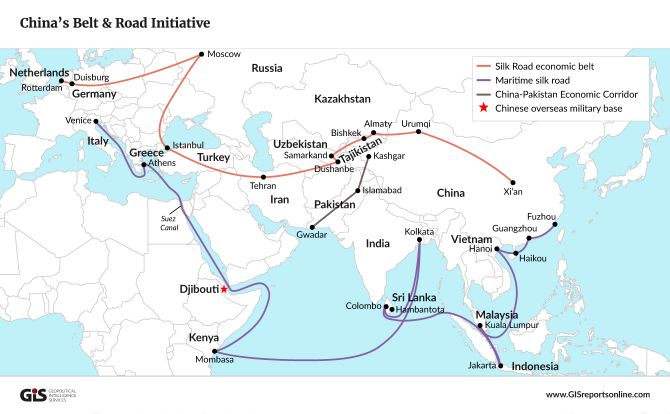
The purpose behind the development of road network and infrastructure of the overland routes is to encourage economic connectivity between Asia, European, and African continents and to take the advantage of the seas of these continents for trade purpose. This will allow to create and network between the related countries and strengthen the partnerships among the countries which are part of OBOR initiative. The OBOR initiative is quite big and devastating in terms of the project scope which is why China has segmented the implementation of plan by dividing the trade and network corridors between different countries. Among those corridors, CPEC is just one of the distinct action plans. CPEC will become part of the ‘master plan’ of the OBOR Initiative by developing the Gwadar Port towards South of Pakistan. The action plan will allow China, the access to the Arabian Sea (Haider, 2013). Through the Road network for the trade purpose will allow entree to the underdeveloped Xinjiang area of China, an opportunity to utilise the under-developed area and access to the Central Asian Republics to be connect with the trade route. The new action plan to re-create the older silk road is much bigger and vast than original silk road, which have been used by china earlier to trade the Silk cloth with European region. The new network plan of the route will provide access to African and the Middle Eastern nations from South Asia, this access was not the park of older silk road route. (Hussain, Ilyas, Mahmood, & Awais, People’s Daily, 2017).
According to the study by (Mubashar Hussain et al., 2017) The recorded increase, in the trade between Pakistan and China according to Pakistan Economic Survey 2013-2014, has increased by 124%. The volume of trade between Pakistan and China has increased from US$ 4.1 billion in the year 2006-07 to US$ 9.2 billion in 2012-13. There was 1% increase in the exports from China to Pakistan during this period and a 400% increase in the exports of Pakistan to China. The share of total exports from Pakistan to China have from four percent in 2008-09 to 10 percent during the fiscal year 2013-14.
Research Aim
Creating a sustainable operation mechanism for highway related road network projects of China-Pakistan Economic Corridor by using the smart motorway techniques.
Objective
CPEC includes many megaprojects including creation of road, railway, sea port and power projects. The dissertation will target the use of smart motorway for highway construction. The first phase of CPEC has been completed in 2018. Second and third phase are due completion by 2025 and 2030 respectively as per stated by (Massarrat Abid, 2015).
To develop the feasibility following are the five steps
|
|
|
|
Research questions
Based on the topic to create sustainable operation and choosing highway construction of CPEC as the study are following are the research question that are intended to be answered by the dissertation.
|

Literature Review
Sustainability
Sustainability has now become a prevalent word in the last few years (Brown, Hanson, Liverman, & Merideth, 1987; Stavins, Wagner, & Wagner, 2003) points out that there are no definite definitions about the meaning of sustainability because of two reasons. Firstly the discussion about sustainability is vastly politicized (Starik & Rands, 1995). The other reason being that involvement of the experts from a different field like biologists, ecologists and economists as the main types of scientists understand the topic from dis-similar angles (Gatto, 2017).
According to (Carroll & Buchholtz, 1996), the most promoted and used definition of the sustainability is that of the World Commission on Environment and Development (1987: 8):
“Development that meets the needs of the present, without compromising the ability of future generations to meet their own needs.”
Figure 1 displays that what are the paradigm of collaboration, which can be used to achieve sustainability from an operation management perspective.


According to (Handfield & Nichols, 1999) in modern context sustainability is to be achieved by the internal and external collaboration among the supply chain partners and the stakeholders. The rise in the consumer and stakeholder expectations is instigating the firms to be fully accountable for their business operations and corporate objectives. Also to be transparent and clearly demonstrating the environmental and ethical behaviour, which their presence and operations are causing globally. Predominantly the organisations are a part of at least one supply chain (Samaranayake, 2005) and in today’s global market struggle caused by increasing competition is increasingly based on “supply chain vs supply chain” (Gold, Seuring, & Beske, 2010). Hence, expected role of accountability and responsibility, needs to be extend along the upstream and downstream supply chains into its services, products, processes, relationships and procurement.
Supply Chain Management
Globalisation and the shifts in the economic trends from western cultural trade to the emerging markets of Asia and East Asia like China, India, Indonesia, Japan and Korea have led to the emergence of highly complex supply chains (Varma, Wadhwa, & Deshmukh, 2006) and the hierchial design, organisational culture, interactive relationship, core competences and capabilities and lastly the administration of the supply chains have become significant matter (Gold et al., 2010).
Figure 2 shows how the Supply chain management (SCM) is vastly relevant in successfully competing in today’s growing market and the trend towards globalisation and international trade market and in dealing with having a responsible behaviour at all steps of the supply chain.
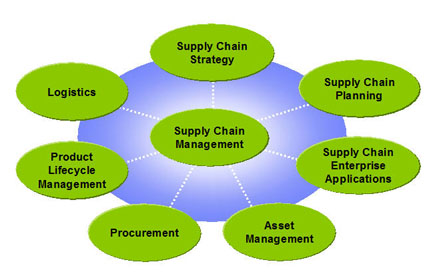
Figure 4 Sustainable Supply Chain Strategies Adapted from Richard Mathews (2011)
It signifies a possibly important discipline for starting how to integrate environmental and social practices, to achieve the success of sustainability. Development of SCM has been largely practitioner-led (Burgess, Singh, & Koroglu, 2006) and signifies an evolutionary phase beyond logistics (Samaranayake, 2005). It extends logistics by the help of integration of the management and the co-operations and co-coopetition of material and information flows (Handfield & Nichols, 1999). The major driver for the fast development in SCM has been economic sustainability, based on the evidence that a combined and efficiently integrated supply chain helps to reduce monetary risks and avoid the uncertainties through collaboration leading to the increase in profits (Fawcett, Magnan, & McCarter, 2008)
However, this should be kept in mind that compliance and goals of the sustainability are not only the phenomenon of developed nations or individual companies for their corporate objectives to publish the yearly Corporate Social Responsibility (CSR) report (Zorzini, Hendry, Huq, & Stevenson, 2015). It is also the responsibility of the public, government, regulating and enforcing bodies to obtain and sustain the sustainability objective. In the previous 25 years, it became important that for for political strategies, achieving national goals, development of cities and communities, and for business strategies (Huq, Stevenson, & Zorzini, 2014). A long-term sustainability and development can only be achieved, if the notion of socially sustainable practices is implemented at different levels; nationally, internationally, internally, externally, in private sector and as a public practice. The diverse levels should interchange information and knowledge to assure an effective progression (Bocchini, Frangopol, Ummenhofer, & Zinke, 2014)
Construction Industry
Construction predominantly is a crucial sector of either developed or the developing nation which employs both skilled and unskilled labour, and provides seasonal employment and opportunities for the businesses and employees of various skills and age. According to (Hoonakker, Carayon, & Loushine, 2010), in the past ten years the construction sector has been criticised for its low performance and productivity relative to other industries. Given the important linkages of the construction industry to various other economic sectors and the linkage with the economic growth, operational costs for construction projects should be carefully managed, monitored and controlled.
Costs related to the quality management, represent a substantial proportion of a company’s total costs. Research on quality related costs, in the manufacturing sector can be valuable to track quality costs in the construction sector. (Yang, 2008) admits that quality-related costs are too significant for manufacturers to overlook, especially when the trend nowadays is towards the globalisation. According to (Juran, 1988), a quality expert, quality-related costs in the manufacturing sector have been significantly greater than revealed in accounting reports. One of the reasons for this can be, the reluctance to take the account of the total cost of ownership. For most of the companies, costs related to the quality ran in the range of 10 –30 percent of revenue, or 25– 40% of their operating expenses. Approximately some of these costs were visible, but some of them were not visible. (Jafari & Rodchua, 2014) research and collected data based on the quality related costs, on the collection of quality cost information from 63 manufacturing companies, reached to the conclusion that quality costs are an average of 2.5– 5% of sales revenues and 7 – 10% of manufacturing expenses. On the other hand, (Hall & Tomkins, 2001) conducted a research in England to measure the cost of quality (CoQ) in a construction project and reached to the result that the total Cost related to Quality were approximately around 18.52% of the project contract amount. In Turkey, (Kazaz, Birgonul, & Ulubeyli, 2005) led similar research and found that the total CoQ averaged 32.36% of the total cost to the client.
It can thus be seen from the findings that by reducing a high percentage of CoQ, construction sector could save a massive amount of a project’s expense. “Most of the literature concludes that it is necessary to transpose and translate the principles, practices, and techniques used for total quality management in manufacturing to construction” (Hoonakker et al., 2010). Because of the success of total quality management practices applied in the manufacturing industry, the techniques of CoQ implementation in the construction industry have also started to gain much attention (Aoieong, Tang, & Ahmed, 2002). Although there have been a very few research on examining the implementation effects of quality techniques and measures in the construction industry but the results outline the benefits to the customers and contractor (Hoonakker et al., 2010). While the worth and significance of quality costs in manufacturing may be well-known, this may not be same in the case of the construction industry (Hamzah, 1993). Moreover, there is no developed and comprehended structure in the construction industry for measuring, defining, collecting, analysing and concluding quality-related costs. Thus, few construction companies have a quality costing curriculum and how those companies will measure for the quality related costs (Davis, Ledbetter, & Burati, 1989). (Tsoi, 2010) add to the findings that a realistic CoQ estimation and advantages from the improvement must be measured and should be essential to any quality inventiveness, and that this is a challenge for any manager.
Environmental Assessment of Building and Highway
The development of sustainability assessment methods and structures in the developing industry, started at the start of the 1990s, at the emergence of the international politics and the discussions regarding to that. “For buildings, the British Building Research Establishment Environmental Assessment Method (BREEAM) was the first sustainability assessment system and it was launched in 1990” (Lee, 2012).The American Leadership in Energy and Environmental Design (LEED) organization was the next in the market in 1998 (Berardi, 2012). Both first generation assessment systems are considered to have a strong focus on environmental features and clearly implant this importance in their description as well (Berardi, 2012).
More modern systems are organized differently than the previous one, new system are focusing less on environmental aspects and going to an alternative strategy which is to apply a more universal perspective. Comparisons have been made with the German DGNB system (German Council of Sustainable Buildings), released in 2009. This have been performed by different authors, such as (Varma et al., 2006)(Grierson, 2009) (Draeger ,2010) and (SZITAR, GRECEA, & VERONESCU, 2012). Until now, BREEAM and LEED have been the best and more significant international evaluation systems for the time being, but regardless of its late creation, DGNB is becoming increasingly relevant (Draeger , 2010).
Several other systems have been produced in other countries; emphasis is on the buildings (Barbosa, Braganca, & Mateus, 2015; Lupisek, Vaculikova, Mancik, Hodkova, & Ruzicka, 2015; SZITAR et al., 2012).The evaluation of effect of different important and relevant groups, such as politicians, construction industry, manufacturers of materials, etc. on the method of producing an assessment system is extremely reliant on the country, their national culture, values and norms (Dadhich, Genovese, Kumar, & Acquaye, 2015). It is not hard to conclude that the importance of separate aspects, depending on the country and the culture can differ depending on the importance which is given to the cultural values and ethics, economy, and tradition of the country (Varma et al., 2006). As an outcome of the previous studies and outlined system, it must be highlighted that sustainability assessment systems should be modern tools, often associated with a country-related weighting scheme and the cultural values, Therefore, systems should be revised and enhanced continually (Brockmann & Girmscheid, 2007)
There are more approaches and systems available for the evaluation of sustainability when it comes to the building industry but not much are there for the civil engineering projects and infrastructure. There are a diverse range of studies available on the sustainability looking in different areas but much is not available specifically for the infrastructure. A first overview of the research in the sustainability in infrastructure projects was given by (Yao, Shen, Tan, & Hao, 2011) and (Fernández-Sánchez & Rodríguez-López, 2010) which is based on Quality of material. There are however some studies which have been published, these are dealing with special types of infrastructures, such as (Clyne, Worel, & Cole, 2011) for roads emphasizing on network design, (Bocchini, Asce, et al., 2014) for bridges emphasising on sustainable procurement and (Beck & Cummings, 1996) for wastewater infrastructure.
What is smart motorway
“Smart” motorways is technology or a technique to create a sustainable operation mechanism in running the traffic flow and calculating the optimized speed limits by Geographic Information System (GIS) and statistical software. These operation management techniques in construction and running of the highways can monitor, control and respond to changing traffic conditions by varying the speed limit for a smoother traffic flow, activate warning signs like a red cross on the digital signboard to alert users of hazards up ahead and the usage of hard shoulder as an extra lean, either permanently or at peak times to avoid congestion that may lead to greater carbon emission through vehicles. Smart motorway techniques are a strategy for becoming more predominant through technology-driven methods such as active traffic management (ATM) systems, hard shoulder management (HSM) control systems for the traffic management, speed calculations, emergency responses and digital enforcement cameras for lane usage and traffic flow optimization. An ATM system is often used to dictate the speed of approaching vehicles and allow the hard shoulder to be used as a running lane either permanently or during busy periods (Highways Agency, 2010; Stevens & Johnson, 2016)
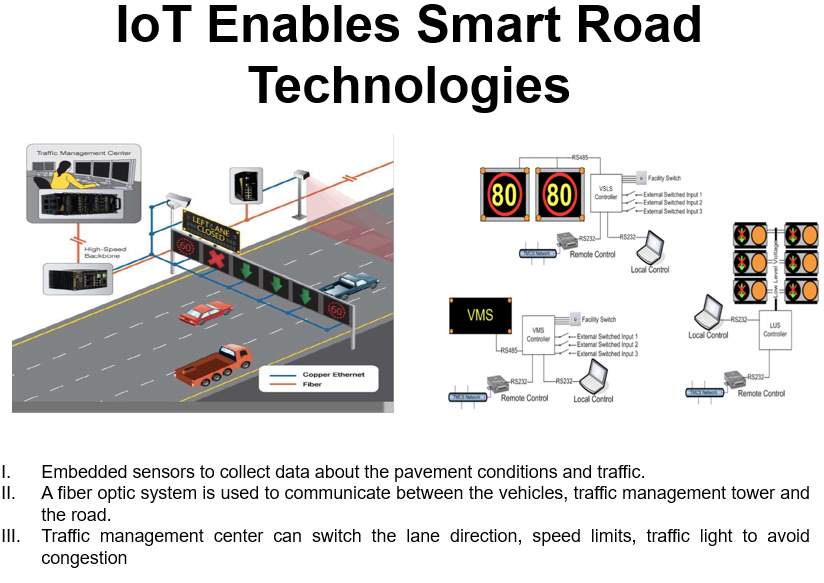
Figure 5 Internet of Things Adapted from Highway England (2015)
Sustainable infrastructure
Road transport is a important source for environmental concern. Road infrastrucute and transport accounts for nearly 20% of total greenhouse gas emissions (EEA, 2007). Many national government have an objective that motorways should be managed in a sustainable way that is sustainable in relation to a low carbon future (Dong et al., 2018). Smart motorway systems are one way or method of a technological solution that is being used now widely and have been introduced in many countries internationally (Highway England, 2016). Any addition of the capacity will be representing barriers and challenges like increased air and noise pollution (Walker and Threlfall, 2016). Evidence from present smart motorway systems suggests that there was no noteworthy increase in the areas in terms of the increased pollution. This could partially be because of the reduced speed limits which allows for a smoother flow of traffic, hence resulting in lower carbon emissions(Highways Agency, 2010; Threlfall, 2018). According to the study by (Ladyman, 2018) vehicles that travel below or above the optimal speed limit, to reduce and minimising carbon emission, approximately between 30mph and 55mph, are producing significantly more emission than when they are being driven at the optimal speed limit. Additionally, (van Vuren, Baker, Ogawa, Cooke, & Unwin, 2012) also argues that a major environmental benefit from the implementation of the smart motorway techniques for a sustainable operation mechanism is that the system, makes best use out of the existing and already developed infrastructure, capacity and space compared to the widening of roads or the construction of new highways. Smart motorway system thus allows to have a lesser negative environmental impact in operations term and makes the best possible usage of the construction of highways.
Smart Motorway
A Smart Motorway is well-defined as a notion that uses technologies and procedures to monitor and respond to changing traffic conditions on motorways as per the description of (Highways England, 2017). Smart Motorways which are being designed now and connected have progressed from several years of feedback, lessons learnt and improvements since their first completion on the M42 motorway in 2006 in Great Britain. We already have evidence of the benefits that a smart motorway scheme can bring, analysis of data collected since the opening of the smart motorway has concluded that
- The journey reliability improved by 22%
- Personal injury because of accidents has reduced by more than the half and
- Where accidents were occurring first now the severity of the incidents was much lower overall with zero casualties and lesser serious injuries. The idea is to research the implementation of the similar project with a sustainable operation mechanism in place for CPEC. (Highway England, 2016)
Figure 3 shows how the mechanism of the smart motorway works for sustainable traffic flow


Figure 3 Smart Motorway Mechanism Adapted from Vinci (2015)
The embedded sensors on road and the CCTV allows to know the volume of traffic and the speed. The information goes to the control centre which then use the statistical software to shoe the optimal speed to be maintained on the gantry boards. This is the mandatory speed limit to be followed. An emergency refuge area can be seen on the figure which is for any malfunction car to wait there for help without disrupting traffic. A detailed explanation is mentioned in the procurement part of the result section.
According to several studies the financial impacts of overcrowding on the highways as the strategic road network is appraised to cost £2 billion per year, a sum likely to increase further due to the forecast traffic growth up to 2035 according to report by (Herrero-Beaumont & Rovati, 2006; Docherty & Mackie, 2010; Clelland, Labour, & Bridge, 2008; Eddington, 2006). One of the aim of this research on Smart Motorways is to analyse the implications of reduce congestion and develop improved journey times by better management of the traffic using roadside equipment structure, related control centres, systems and operational rules. Smart Motorways support the economy if there is full volume of activity on motorways, while preserving safety for motorists and those who work on the roads. Other benefits of different types of Smart Motorway active regimes have included decreases in accidents and reduced impacts on the environment related aspects with emissions from still or slow-moving vehicles stated by (Gatto, 2017; Wilson, 2017). In a business context these smart motorways will have an impact on more social issues which individual businesses are reluctant to deal with, even under the triple bottom line. Business groups in the world must face an increased concern over the rising carbon releases that directly impact the climate change, furthermore the scarcity of resources and waste that is generated because of the inefficient usage of resources. Nowadays the business environment and companies are facing foremost challenges rising from resource constraints; furthermore, rising energy and fuel prices causing irreversible damage according to (Dadhich et al., 2015). As the environment should not only be the concern of the businesses but also of the people and the government than in that sense smart motorway techniques on CPEC route is a kind of procedure that will not only be helping the businesses in the transportation problem but all the users of the route including the other countries interested in this project like China and Russia, with improving trade and economic relationship of Pakistan with the other countries while creating a socially and environmentally beneficial route that will be able to tackle the problems of climate change by using renewable energy and sustainable operation and also the exceeding usage of vehicles because of expansion of metropolitan areas as well as population growth problem of Pakistan and China as more people are buying more vehicles than there is not only a need for more infrastructure but also a plan by which such megaprojects would be able to work out efficiently and effectively even for the upcoming generations. The research also plans to look one of such process which will be able to entertain the need of growing population and more vehicles not only now but also on the foreseeable long-term future.
Generic Internal Organisational Factors
By reviewing several journal articles on the infrastructure projects on developed countries some common factors have been identified and interpreted in terms of how they will act as a constraint while implementing smart motorway on CPEC project. The factors have then been interpreted specifically for the smart motorway project on CPEC. According to (Mehmood Hussain, Mehmood, & Saeed, 2017) these internal and external factors are as follows:
The work force factor
From the report of (Assessment, 2017) it have been found that the efficiency of the workforce to carry out its goals is one of the main reasons, for the progression of organisational achievement. However, Mega-projects such as CPEC are reluctant to cut the quality related cost of the highway like durability and sourcing of the correct material and the delivery of the project on time and on budget. The lack of expertise required to carry on with the project may cause trouble and lack of trust between the stakeholders involved in the project.
The management factor
According to (Mehmood Hussain et al., 2017) any organisation requires effective management to reach its goals; thus, land, material and labour resources are not enough. An organisational facility must be provided to directly achieve the goals effectively. In terms of Smart motorway on CPEC the regulatory and enforcing bodies such as ministry of development and National Highway Authority are the regulatory bodies. These bodies must be competent enough to set aside the political concern from the environmental, social and economic concerns.
The organisational system factor
According to (Hofstede , 1973) organisational system and organisational culture depends on the internal relationship with the employees. Also the resistance to adapt to change and the level of uncertainty avoidance to accept new process and technology. A new project may require a change management system. An integrated process with good communication and good international relationships with the supply chain partners and across border of the road transport is being used as an international trade passage. As in the CPEC project in Pakistan.
External organisational factors
The environmental factor
From the report of (Assessment, 2017) during the Construction of highways, a problem can be the impact that will be there on the environment because of the deforestation. The small or external stakeholders such as farmers and the effect on flora and Fiona pre- and post-construction may not be given much consideration. Having an environmental impact assessment and an audit is a good practice for massive highway projects. This helps prevent barriers and problems that could render the control process difficult and significantly impact the environmental outcome, resulting in project failure.
The external force factor
It can be deducted from (Gil, 2009) that although the assumption that timely completion of the project is only interest of the enforcing bodies and government. Obviously, general users want projects done in accordance with the highest level of quality at the lowest cost and timely manner as public funds are being utilised for such highway projects. Some areas of the highway may be sub-contracted and some functions may be outsourced or near shored. In CPEC project, China and Pakistan are the main partners. Many projects have been sub-divided into Chinese contractors. That is why the client approach to project delivery is changing from traditional methods, such as cost-plus contracts that negate CoQ computations to contractors, to new methods, such as lump-sum contracts that help contractors save on expenses by avoiding non-conformance costs. Therefore, the organisation’s quality costing system must assure clients and other stakeholders of compliance by the contractors.
Smart motorway techniques on the CPEC project will allow to attain the sustainable operation mechanism for the road transportation for the general users and for the trade purpose nationally and internationally. Studying sustainability from the Operations Management (OM) field is essential for two fundamental reasons: First, to account for the energy and other resources that are used and the resulting footprint they leave behind. The primary activities that contribute to their footprint are the production, transportation, recycling and remanufacturing of current products and the design of new products; therefore, it is clear that OM on CPEC, in the transportation terms can contribute to reduce this footprint (Kleindorfer, Singhal, & Van Wassenhove, 2005). Second, organisation need to operate in a prudent and responsible manner and be responsible for the quality of life of the external community. As Operations is one of the areas employing the most personnel and having the highest footprint and impact on the external community, it can have a significant effect on sustainability’s social dimension. In summary, ‘‘given the impact of the construction industry on the environment, people and economy, OM gives new opportunities to significantly contribute to sustainability’’ (Golini, Longoni, & Cagliano, 2014, p 10) Smart motorway techniques in developing country will hence contribute to achieve a sustainable operation, better fuel efficiency of vehicles, less carbon footprint, smooth traffic flow, less traffic congestion and less effect on the climate change because of carbon emission. This will allow to achieve the sustainability under the triple bottom line, the different ways and paradigm of achieving sustainability according to the triple bottom line are mentioned in Figure 4 below.

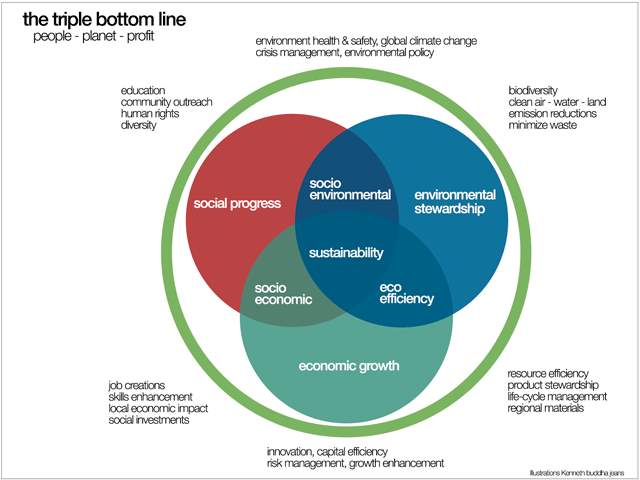
Figure 4 Triple Bottom Line Effect Adapted from Tanya and Timothy (2011)
China-Pakistan Economic corridor routes
Eastern route of CPEC will pass through the existing and developed infrastructure of the Pakistan. The already developed infrastructure will be improved and the existing motorways will be used. The route will pass from the main province of Pakistan which is Punjab and the most developed, connecting all the metropolitan areas. An additional lane and emergency services will have to be constructed on those motorways and the Fibre optic connectivity throughout the route will provide an incentive for the communication and intranet to control the motorway traffic and speed variables to avoid congestion. This is a smart motorway technique. Eastern route consists of 1152 KM Motor highway with 6 lane estimated cost $ 6.64 billion. (Abid & Ashfaq, 2015). Figure 7 below shows the path of Eastern route on CPEC.
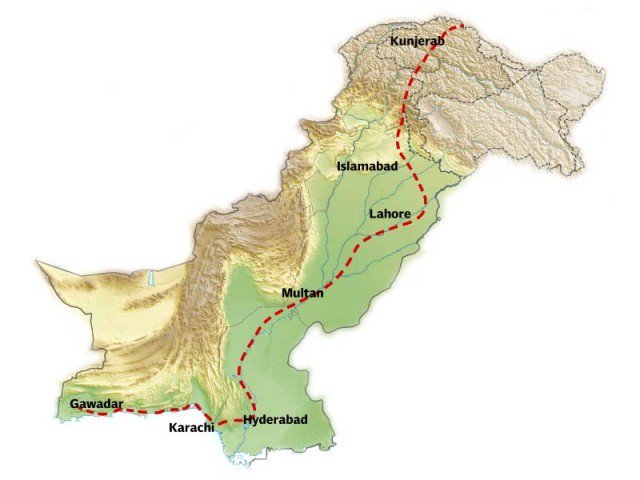
Figure 7 Eastern Route Adapted from Tribune (2015)
The Western Route is the part of the Pakistan, which is not much developed and requires a major investment in the term of creating a road network. This route will pass through the mountainous areas of Pakistan in the Province of Khyber Pakhtun Khwa and merge with the eastern route in the same province. The both merged routes will than go on further towards China (Aqeel, 2016). All the fibre optic connectivity will have to be provided and the construction of road infrastructure will take more time compared to the eastern route. In this part implementing the smart motorway techniques and proper connectivity might become a challenge. Figure 8 shows the Western Route, this is the original route of CPEC and the route is shorter than Eastern Route (Tribune , 2015)
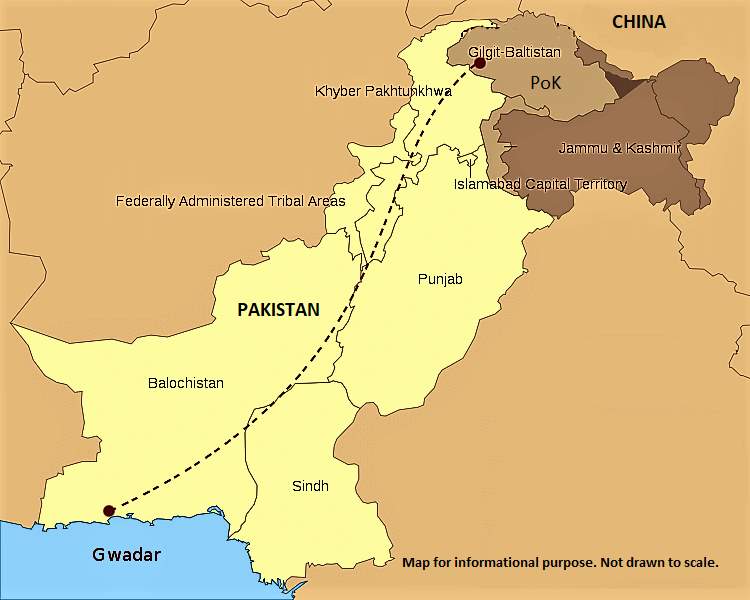
Western Route
Figure 8 Western Route Adapted from Tribune (2015)
Research Methodology
The location of Pakistan provides it an economic advantage for freight transportation Afghanistan, China, and the Central Asian. Pakistani users have changed the mode of transportation focus from railway to roadway network. An increase in the users of light weight vehicles have been seen in the past decade. The current roadway networks and infrastructure are incapable of the usage of roads as a commercial trade-way. Migration to metropolitan areas has increased usage of vehicles and congestion on Pakistan’s highways. The military freight, urbanization, motorization, and creation of the infrastructure as a trade network have increased risk to road users. The World Health Organization reported 25,000–30,000 annual deaths in Pakistan for the road accidents. To decrease traffic congestion, Pakistan must review national transportation policy and the usage of different mode of transport. The dissertation is a mean of filling this research gap by investigating the feasibility of smart motorway on the CPEC route which will create a road network infrastructure and operational mechanism, suitable for long-term trade plans of Pakistan. The research onion and the result analysis approach have been mentioned in the section below to address the research gap, taking a case analysis approach for the result part. The Epistemology theory is more suitable for this particular dissertation on the pragmatic philosophy as according to (Saunders, Lewis, & Thornhill, 2008) observable phenomena and subjective meaning are used to provide acceptable knowledge dependant on the research question to integrate different perspective in order to interpret the data.
The research method use the research onion approach in the collection of data and the deduction of research outcomes. A Pragmatism research is followed in this dissertation as the Pragmatism argues that determinants of epistemology, ontology and axiology revolves around the research questions as per described in (Saunders et al., 2008). The research question for the dissertation have been highlighted in the introduction section and revolves around the operation management and sustainability perspective. According to the pragmatism philosophy it is possible to work with the variation of positivism and interpretivism (Bryman & Bell, 2003). Considering the fact that, variation is there to find answer to the research questions, this will make the result section descriptive in the dissertation as the result section of the dissertation makes use of the different theory learned throughout the academic year to make sense of the secondary and primary data collected to reach the feasibility and the readiness of the project for the users of smart motorway.
Data Collection
The area of study of the dissertation is based on the quantitative research mechanism because the main source of primary data collection was questionnaire, which allowed the interpretation of readiness index and allows for a deductive approach. The survey, case study and archival research methods are used as an approach for the quantitative research mechanism.
Survey allows to collect the data and is associated with the deductive approach. The survey data collected for the dissertation allowed to consider a pilot project, readiness and SWOT analysis as a strategy to implement the smart motorway project and produce models highlighted the result section. Case Study on CPEC allowed to investigate a contemporary phenomenon in a real-life context, highlighting the importance of the research on smart motorway. This method allowed to come up with the change management strategy which have been learned in the academic year and made use of my own interpretation of the subject matter to come up with the Pilot project and how to use change management strategy. Case study also helped in strategizing a procurement and contracting strategy in the result section, as well as finding the answers to the research questions outlined in the introduction section. Lastly Archival result helped to make use of the secondary data and the administrative records on the highway project in Pakistan and in England, also the report from world health organization outlining the problem of congestion in Pakistan and the reports on the CPEC project. These reports helped to come up with the risk and the institutional framework highlighted in the result section, for CPEC and highways in Pakistan as well as the need for change in the operation management in techniques for traffic control. Based on the principal of data collection and interpretation as can be seen from the result section of the dissertation the dissertation will be theorised as a quantitative research.
Secondary data have been collected from World Health Organisation and United Nation reports on the developing nations. Research articles from Elsevier, Science Direct, Scopus, Google Scholar, Wiley, Emerald Insight, Pakistan CPEC website, and Chinese media articles translated by using google translate. These secondary sources were the means of developing the procurement strategy for the implementation of smart motorway on CPEC, which have been highlighted in the procurement strategy section. Pakistani newspaper, institution report of Pakistan, Highway report of Pakistan, highway report of UK and various supply chain, operation, construction and infrastructure related journal articles and research reports were used to know the current governance structure of the CPEC road network project. A summary of the governance structure was taken from www.cpec.pk which is the official government website and secondary sources from different media reports and newspapers were used to interpret the governance structure that will be required for the smart motorway project. This have been included in the institutional framework section of the dissertation. The previous projects of Pakistan motorway were compared with the smart motorway project of UK, to know the risks involved and how to mitigate the risk. Reports from Highway England and Pakistan National Highway Authority are used to figure out the generic and common risks involved and the mitigation strategies for those risk have been interpreted. This have been mentioned in the risk section. Lastly the secondary data and the primary survey were used to come up with the SWOT analysis of smart motorway through newspaper and journal articles on infrastructure projects, this also helped in creating a network readiness index as survey gave insight into how the users will perceive the smart motorway on CPEC. The data of primary survey have been collected from the sample of Pakistani population.
E-mails for phone interview and latest data for the highway report were sent to government officials as the last reports were of 2013 and this year report were to be published in 2018. Because of the change of government and the Election period going on no reply for the telephonic interviews or latest secondary data could be collected. Based on past reports and latest journal articles on sustainability, operations and infrastructure this dissertation will be highlighting the key risks based on the implementation of smart motorway on CPEC, institutional framework which is being followed now based on the CPEC website created by government of Pakistan and proposed changes that are required for the smart motorway to work, lastly the procurement strategy that could be used for the smart motorway network.
Primary data have been collected by the questionnaire designed which asks for the respondent knowledge about CPEC, smart motorway and will they support smart motorway on CPEC project. The target sample was on the convenience based as this is a vast and complex topic and because of the election period there was difficulty in communicating and getting reply from government officials. The questionnaire has thus been targeting the Educational institutes of Pakistan based on the professors and students involves in civil engineering and development studies. Based on the previous reports and the feedback on the questionnaire a pilot project has been proposed for the smart motorway techniques and the readiness index will be formed based on how much the respondents knew about the CPEC project and from where they get there knowledge from as well as how much they know about smart motorway, what do they know about smart motorway, where do they get there knowledge about smart motorway and what do they think about the smart motorway techniques on CPEC route.
To experience the techniques of smart motorway and the benefits to the users, two round trips which were from Manchester to Birmingham and Manchester to Leeds were made. In those trips some questions were asked from other passengers and the bus drivers on how effective they found smart motorway and how often the passengers travel through bus. Although this did not have much to do with CPEC research directly, but it gave an idea of how the users rate the smart motorway techniques in UK.
To assess the primary and secondary data collected in the result section an approach in highlighted below.
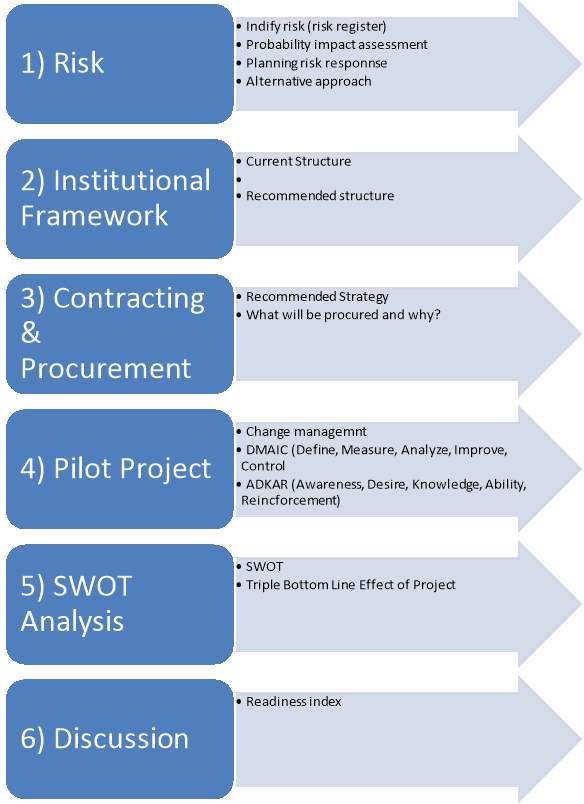
Table 1 The Result analysis and discussion approach
Research Method
According the research onion developed in (Saunders, 2015) the research collection of data based on the primary and the secondary techniques have already been mentioned. Because of the time limit of the study and submission the longitudinal research was not much of an option which is why the cross-sectional method by targeting different respondents during the research period have been adopted. Based on the secondary data and the primary data collected from field survey by making two round trips and respondent feedback on the questionnaire this dissertation is based on the multi-method approach to discuss the feasibility. The study is based on the archival research by collection of secondary data on the related topic and past studies, survey research by questionnaire approach and round trips as well as the case study of the CPEC road network and power projects.
Overall the dissertation will be classifying as a deductive research as the research is based on testing the hypothesis of the feasibility of smart motorway techniques on CPEC and the theories used to test the hypothesis are already existing and although a specific research on this topic have not been done before but studies on the smart motorway, highways and construction industry are done. This dissertation is an attempt to merge the concepts of supply chain, operations, sustainability and construction industry (specifically highways) that may also help to create a supply network design by road network transport in future studies. The variables and merging the concepts of different areas into a sustainable operation study makes the dissertation a bit complex but not outside the regime of deductive research approach. Based on the primary data collection techniques and the prior insight to the research are the dissertation will be a pragmatism research philosophy. The pragmatic research helps to find the answers to the research questions, which have been stated and aim to contribute to the practical solution for the problem solving. The problem-solving solutions in the dissertation highlight the risk, institutional framework and procurement strategy for the smart motorway. The aim of dissertation is to interpret and build on the past knowledge and user behaviour and mind-set today to interpret an existing method in another economy which is culturally very different than previous one, so rather than to generalize the enabler, blockers and criticality it is based on the motivation and understanding of the subject matter, which is sustainable operation for highways. The interpreted and comparative analysis have been used as the result to analyse the feasibility of smart motorway by using procurement strategy, institutional framework, risk structure, readiness index and SWOT analysis of the implementation by means of the dissertation. The result part of the dissertation is an interpretation of the primary and secondary data as a case analysis approach for the feasibility of smart motorway project. The methods used to come up with the analysis of the dissertation as per highlighted by (Saunders et al., 2008) have been mentioned below.
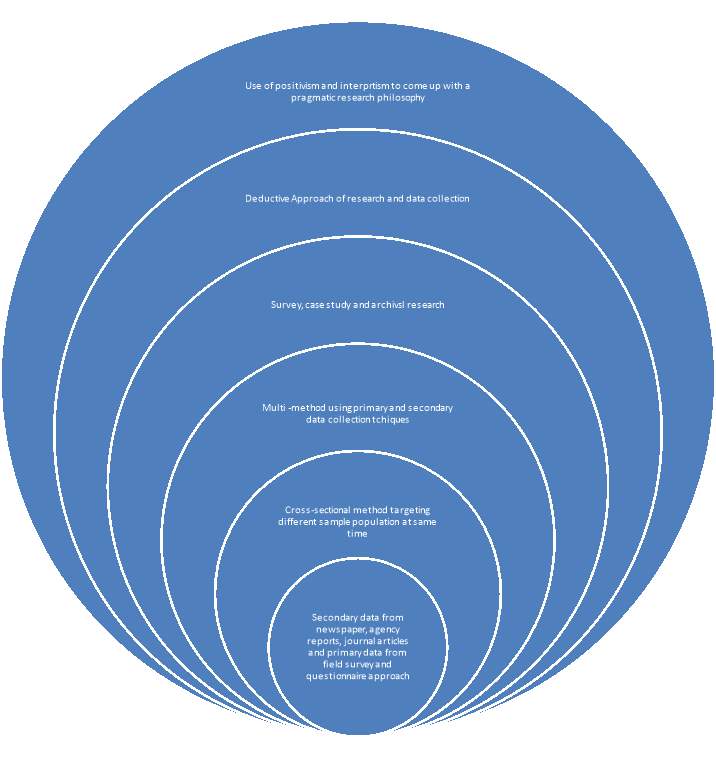
Table 2 Research Method used for dissertation
Project Risk Management
1. Identify Risk (Risk Register)
The risk register is a document where the outcomes of risk analysis and risk response planning are registered (Project Management Institute, 2013). Although the forms of this process could differ based on projects and organisations, some core elements should be included as shown in figure 1(Leva, Balfe, McAleer, & Rocke, 2017). According to the study regarding risks in motorway projects (Carbonara, Costantino, Gunnigan, & Pellegrino, 2015), some risks are identified as major components which could affect the motorway projects. Figure 1 illustrates the type of risks, priority, responsible entity, and counter measures. As toll collection is the only source of revenue, demand and usage of motorways are key to commercially viable projects. According to finance department of government of Pakistan the projected income from CPEC project will be $ 135 billion. However, it is highly likely that actual traffic is lower than projections during the early years and this significantly affects the economic sustainability of projects. Traffic projections consist of diverse factors and drastically change based on the assumptions like cargo usage and balance of payment trend. For example, Pakistan economic growth is lower than projected, it could reduce the number of traffic.
Financial risks (interest rate risk and foreign exchange risk) are also considered as significant risks. Since the payment is not made in hard currencies, there is a high change that Exchange rate could be fluctuated. Right now, according to various media reports the outstanding loan on CPEC to Pakistani government have exceeded $50 billion. Implementation of smart motorway will mean a further need for finance but that will not be significant compared to the major power and network projects going on now. Looking to the recent smart motorway projects and comparing to the cost of smart motorway on M25 highway of England a total of $2 billion are estimated cost for smart motorway on existing highway of the CPEC project. The project is also exposed to changes in interest rates if Chinese government does not provide fixed interest rate loans. The rest of the risks are related to the technical capability of contractors. It is essential to select a contractor which has sufficient experience in that sector as well as the other risk mitigations.
For the CPEC road network the tier 1 contractor is China State Construction Engineering Corporation and for the smart motorway the same contractor will pursue the modification of fibre optic network for communication and signalling capabilities and additional lane which will form the part of design risk, performance risk, and time risk. The use of single contractor is more feasible as dealing with different contractors may delay the project and create contradictions in the view of different contractors, hence effecting the overall quality of the project. According to the highway reports the Chinese contractor is fully capable of infrastructure and communication projects and dealing with the mega-project is part of its core capabilities. Hence single sourcing for the contract and procurement strategy is preferable on either the lump-sum or turnkey contract basis to avoid cost over-run. To motivate on the performance the incentives like more contracts in future or making the contractor the development partner in upcoming project, as well as providing commission on the revenue earned for the early years can boost up the performance and quality of the contractor.
| Risk
ID |
Risk
Description |
Risk Ranking | Owner | Reason |
| A | Demand / usage risk | 1 | Pakistani government | Projection is based on estimation. |
| B | Interest rate risk | 1 | Ministry of Finance (Pakistan) | Volatility of home and foreign interest rate. |
| C | Foreign exchange risk | 1 | Ministry of Finance (Pakistan) | Volatility of home and foreign exchange rate. |
| D | Cost overrun | 2 | Contractor | Time delay, plan change, scope change |
| E | Design risk | 3 | Contractor | A contradiction in views of client and contractors. |
| F | Delay in completion | 3 | Contractor | Partial completion because of uncertainties like political instability. |
| G | Failure to meet performance and quality | 3 | Contractor | Less site visits, over-dependence on contractor, high switching cost. |
2. Probability and Impact Assessment
Qualitative assessment is crucial part of risk assessment. One of the most commonly used technique is the Probability–Impact Matrix, in which the probability and impacts of each risk are classified on a two-dimensional grid (Hillson, 2002). Demand and financial risks (exchange rate and interest rate) are placed in the red zone. This area is called the arrow of attention which is a focal point of risk management. Although conventional matrix focuses on negative impacts on projects, this model analyses threats and opportunities. This could allow project managers to analyse projects more holistically. It is apparent from this matrix that significant risks tend to have both negative and positive aspects, whereas for minor risks showed only negative effects on the project.
According to the model the demand usage risk depends on capacity and volume of vehicle usage of smart motorway. If the usage is optimal and greater than projected this means that smart motorway will generate greater income and is an opportunity. Vice versa if vehicle usage is lower than forecast than it is a threat as Capital investment could not be recovered, as well as the operational and maintenance expense will increase the cost further. Less income will be generated to payback the debt. Demand usage is thus also linking the finance risk, which means that only exchange rate and interest rate volatility are not the financial threat but the ability of smart motorway usage to generate income to payback the debt is also an operational concern.
Finance risk becomes an opportunity only because the smart motorway project is directly linked with the assumption that it will generate income because the economy will grow because of the increased trade and CPEC network usage. Growth of the economy means that monetary policy and fiscal policy will impact the Tax and interest rate income. Rise of economic stability will provide appreciation of home currency and opportunity that less will have to be paid back in terms of exchange rate and interest rate. Vice versa if the assumption fails and the project is delayed or the income could not be generated because of the political instabilities than more will have to be paid in terms of exchange rate and the interest rate.
Cost over-run is only a threat because the estimates of the cost made by the Ministry of Finance (Pakistan) do not consider the rate of inflation, Relative growth rate of economy and the discount factor is just an estimate. If the project is not completed by 2030 as per projected than cost over-run is major concern and threat as operational cost will increase. There will be less income stream to compensate for the extra cost, there is also a risk of cost over-run because of changes in the design of motorway, compensating the external stakeholder like Non-governmental organisation and media groups who exploit the government agenda to make money by negative publicity. These are the reason that cost over-run is also the part of the arrow of attention.
As single sourcing is being used for the smart motorway implementation the risks that are particularly associated with the Tier 1 contractors fall outside the arrow of attention. They are also low risk because lengthy negotiations with different contractors will not go on, hence there will be a lower transaction cost if single sourcing is used as more of the transaction cost will be transferred to Tier 1 contractor who is further responsible for the completion of project. But this strategy will increase the dependence on the contractor and give less scope to change the contractor in later years, but based on the capabilities and core competencies the risks are low during this period.
Table 4 Probability Impact Matrix
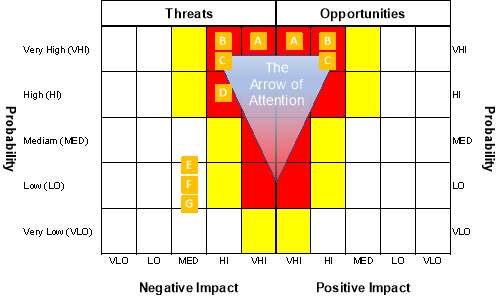
3. Plan Risk Responses (Strategies for Risks)
The final step of risk management is to plan risk response strategies. Typically, avoid, transfer, mitigate, and accept are used in this planning. For the opportunity side, exploit, share, enhance and ignore are useful classifications (Hillson, 2002). Interestingly, this model shows that most of the risks are transferred to the parties who are capable to manage these risks, whereas for demand risk, it cannot be transferred to the third party since there is no appropriate entity to assume this risk. From opportunities’ perspectives, mitigate and transfer are converted into enhance and share respectively.
Table 5 Risk Response Strategies (Threats)
| Risk
ID |
Risk
Description |
Risk Strategies | Description of Strategies |
| A | Demand / usage risk | Mitigate | Conduct sufficient feasibility studies to mitigate downside risks |
| B | Interest rate risk | Transfer | Chinese government provides fixed interest rate loans so that the borrowers are exposed to the interest rate risk |
| C | Foreign exchange risk | Transfer | Concessional loans are denominated in Pakistani rupees so that the borrowers are not exposed to the foreign exchange rate risk |
| D | Cost overrun | Transfer | Transfer the cost overrun risk to a contractor by using lump-sum contracts to determine the total budget before implementing the project |
| E | Design risk | Transfer | A single contractor is appointed to wrap up different contracts including the design |
| F | Delay in completion | Transfer | Any losses due to delay are covered by liquidated damages provisions or bonds |
| G | Failure to meet performance and quality | Transfer | Any losses due to low performance are covered by payment reduction or bonds |
Table 6 Risk Response Planning (Opportunities)
| Risk
ID |
Risk
Description |
Risk Strategies | Description of Strategies |
| A | Demand / usage risk | Enhance | Conduct sufficient feasibility studies to enhance probability of upsides |
| B | Interest rate risk | Share | Chinese government shares the benefits if floating interest rate is in favour of them |
| C | Foreign exchange risk | Share | Chinese government shares the benefits if foreign exchnage rate is in favour of them |
4. Alternative Approaches of Risk Management
As shown in the risk response planning, construction related risks tend to be transferred to contractors because it is believed that contractors are best positioned to manage this type of risk. However, as can be seen in the terminal 5 development of Heathrow airport (Gil, 2004) it is possible that a client assumes all the risks so that the relationship between clients and suppliers could be more collaborative. In the case of smart motorway, the Government of Pakistan will take all the risk. Another advantage of this strategy is to reduce the cost of risk premium that contractors add in their initial budget outlay. If risks are transferred to the other parties like the contractor then, transferred risks are converted into the increased price. This have been identified in the probability-impact matrix that construction risks are not as significant as demand and financial risks. Hence, it could be effective for the owner of the project, Government of Pakistan to accept the risks rather than transferring, allowing to reduce initial cost but exposure to the risks associated with the contractor.
This approach could be more cost-effective than traditional approaches, deliver the project on time, and avoid any negative behaviours such as legal disputes. Hence, it could be manageable for National Highway Authority of Pakistan to accept the risks rather than transferring so that the project could be delivered more efficiently and effectively. However, it should be acknowledged that capacities and expertise of National Highway Authority needs to be assessed when choosing this innovative approach. It is important to examine whether National Highway Authority is eligible.

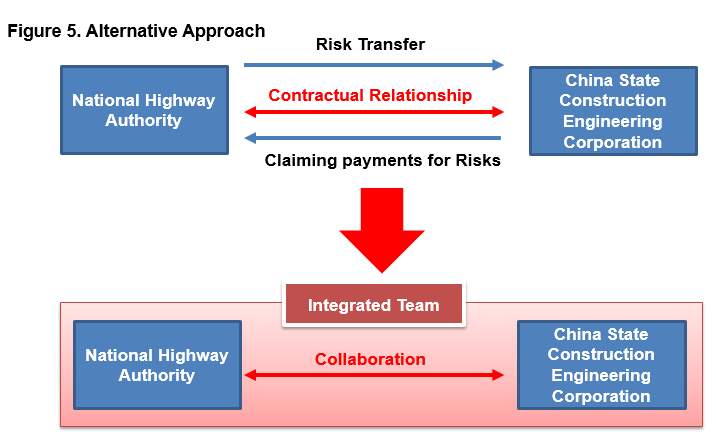
Institutional Framework
The structure, roles and methods of organising activities in a project and programme management environment is defined as ‘governance’ (PMBOK, 2015). Organisations develop governance structures to provide, guidance, decision making and oversight of their strategic management framework (De Teresa, Fernandez-Pacheco, Cordoba, & Ibarra, 2008). There are many approaches to governance structures in the organisational and project context, however for this project, a collaborative governance structure is being proposed (Ansell & Gash, 2008). Collaborative governance in comparison to the managerial and adversarial governance structures involves both internal and external stakeholders in the decision-making process with government institutions (Ansell and Gash, 2008). Critics of CPEC argue that the current CPEC institutional governance structure clearly reflects that it is hierarchical and federated (Shah, 2017). Both the Chinese and Pakistani governments have denied this criticism repeatedly. The research into CPEC shares the view of the critics and therefore, the proposed governance structure for the Smart Motorway Project be collaborative including all the key stakeholders. The project also proposes that the National Highway Authority which is the implementation agency of all motorway projects under CPEC to adopt a collaborative approach by distributing the work by engaging with several contractual agreements with different firms, in order to engage the suppliers in co-opetition.
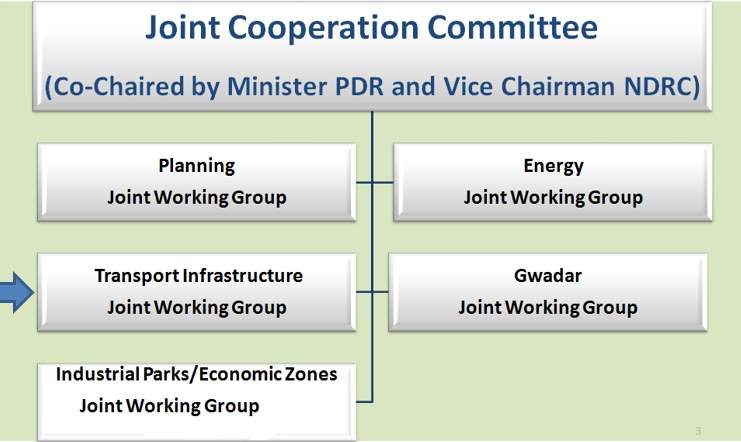
Figure 10 Institutional Framework Adapted from cpec.gov.pk
The current institutional framework is very federated and bureaucratic, where the government of Pakistan and government of China have all the decision-making authority. This kind of institutional framework is reluctant to take the interest of minor stakeholders in account. For the smart motorway project many of the minor stakeholder like farm owners and those who are not properly compensated for their land acquisition by the government for the infrastructure development leads to a social cost under the triple bottom line. Likewise, there are environmental impact of soil erosion and deforestation when the route asses through mountain area hence having a negative environmental impact. Although the smart motorway will help in reducing air pollution by less carbon emission but at the expense of air and water pollution.
The internal stakeholders now are Joint working group (JWG) which is made up of the representatives from Pakistan and China. The group is the governing body who is responsible for approving or declining any amendment on CPEC, the same group will overlook the implementation of smart motorway. Ministry of communication of Pakistan (MoC), National highway authority of Pakistan (NHA) are the two-internal stakeholder who are the regulating body for the motorway projects and establishing a stable communication network of fibre optic connectivity, which will be used for the data and information transfer for the smart motorway. Both of this internal stakeholder will be working under the (JWG). China communication and construction company (CCCC) as well as with the China State construction and Engineering corporation (CSCE) are the representative companies of China for the communication and infrastructure work. A collaboration of the Chinese internal stakeholders and the Pakistan internal stakeholder will be essential for the smart motorway on the CPEC.
There is external stakeholder like Joint co-operation commission (JCC) which is co-chaired by Ministry of planning, development and reforms (MoPDR) from Pakistan side and National development and reform commission (NDRC) from China. These bodies are looking after the developmental goals of their representative economies and as CPEC is a joint project, JWG will require approval from respective countries in this case from JCC for the implementation of smart motorway.
The problem with the current structure is that it does not involves many of the key external stakeholders who might be essential to the project. A collaborative framework is required by making the key stakeholders either the development partner, or hybrid model of centralised and decentralised network where external stakeholder have some decision-making authority depending on the provincial and regional concerns of the effected and minor stakeholder.
Table 8 Current Institutional Framework
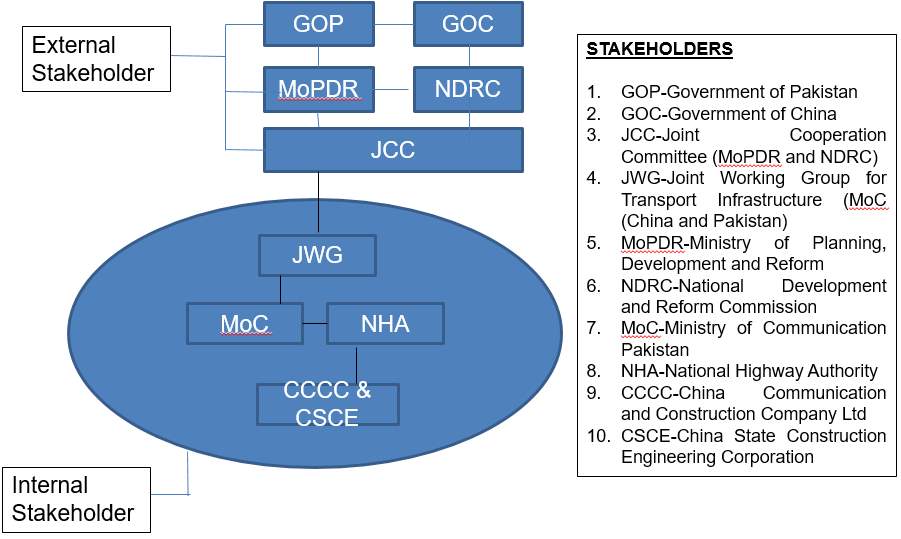
An alternative to the current institutional framework is being proposed to include the local government of province (LG), local businesses (LB) and the non-governmental organisations (NGO) as an external stakeholder. Although there is not much need to give these stakeholders a decision-making power but the Local governments will be able to raise the concerns of the minority stakeholders like farmers, fisherman and of those who are now homeless because of the land acquired. Hence the inclusion of these stakeholder will help in mitigation the social costs under the triple bottom line as an operational concern.
Furthermore, the inclusion of a few other ministries like ministry of finance (MoF), ministry of information technology (MoIT), ministry of environment and development (MoED) and the ministry of energy and power division (MoEPD) as an internal stakeholder is also beneficial practice for a collaborative framework. There are two reason for the propositions. Firstly, the MoF is responsible for considering the financial budget and usage of the finances on different projects so any foreseeable cost over-run or requirement of extra finance will require an adjustment in the fiscal and monetary policies to raise finance. Smart motorway requires an intranet network for stable communication and changes on the digital signboard which requires the expertise of the MoIT. CPEC consists of various renewable energy and coal power project other than road and rail network. Implementation of smart motorway to reduce economical cost under triple bottom line might contradict with the goals, scope and budget of the power projects. Around 13300-megawatt energy have been estimated by the implementation of power projects, which will allow redevelopment and creation of various economic zones in Pakistan and to generate more GDP. The increase in the manufacturing capabilities will mean that roads will increasingly be used for the transportation of manufactured goods. There is a possibility that renewable energy will be used to power the highway lights and digital signage for the smart motorway which means involvement of MoEPD is reasonable. As already discussed that smart motorway might cause the reduction in air pollution at the expense of land and water pollution than the involvement of the MoED will allow to have a feasibility study of the land or route from where the smart motorway will be developed. It will also provide the study of the effect to the flora and Fiona and what could be done to minimize environmental costs under the triple bottom line as an operational concern.
Second reason of involvement of ministry is to create a collaboration as CPEC has many projects going on. This collaboration will allow to minimize any contradiction with the other projects. Inclusion of external stakeholders will allow to minimize the contradiction with the local government goals, this whole framework will lead to a more reasonable goals and target which can be achieved more efficiently. One other suggestion is to bring in more suppliers or contractors to avoid the dependence on few suppliers and create a mechanism of co-opetition among them. This will allow collaboration among different contractors and low switching costs with a relationship based view approach of dealing with the upstream supply partners.
As shown in the alternative governance structure, collaborative governance is suitable for a democratic decision-making process. By inclusion of the ministries of Environment, Finance, Energy (Power Division), and Information Technology as internal stakeholders will be beneficial in risk planning, risk identification, risk management and risk mitigation. As the current structure does not reflect the key risks identified above in the risk section of the dissertation. The risks identified will be addressed effectively with the collaborative framework and allow better operational efficiency. The National Highway Authority as the implementing agency can distribute the risks to the relevant ministries mentioned. The inclusion of local governments, businesses and non-governmental organisations as external stakeholders in the governance structures will allow better legitimacy of the claims on regional and local stakeholders effected by the project and enhance the transparency of the smart motorway project.
Table 9 Recommended Changes to Institutional Framework
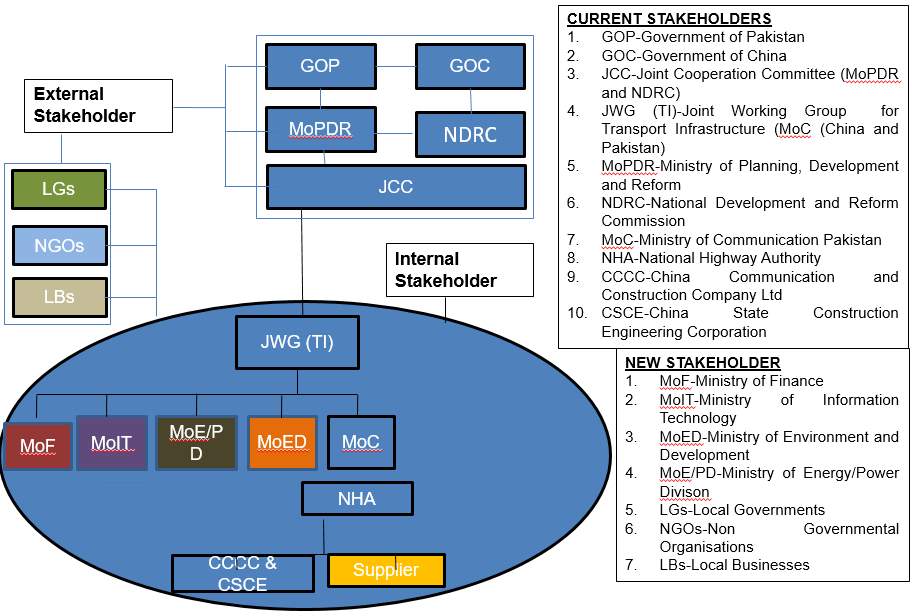
Contracting and procurement strategy
Since the new pilot Motorway Project is highly capital-intensive which is why the National Highway Authority, China state construction engineering corporation and China communication and construction company needs to purchase a lot. The road side equipment, communication technology, energy or power connectivity, communication connectivity using fibre optic cables, sensors for speed of vehicles, emergency equipment and CCTV will all need to be embedded. There will also be a need for digital signage and power connectivity to the signboards. In this way, the project requires a procurement policy, which means a procurement strategy. From the leadership perspective, there is a strive to pursue collaborative governance by contracting and procurement strategy, in which designing a Contracting and Procurement Map is requisite. To realise that, there are four elements to consider:
- Power-the choices we have; the part we want to control directly; environmental constraints we face;
- Transaction costs-uncertainty, frequency and specificity;
- Capabilities analysis-the aspect we and the suppliers are good at;
- Organizational identity.
The four elements used indicates the whole strategy is multi-determined. As a matter of fact, it might be impossible to work out an optimal strategy, however it is compromising of outcomes which is beneficial for controlling the complexity. Based on the above 4 forces, we make strategic choice on whether to implement in-house by CSCEC or to sign specific procurement contracts with suppliers.
Table 10 Recommended Procurement Strategy
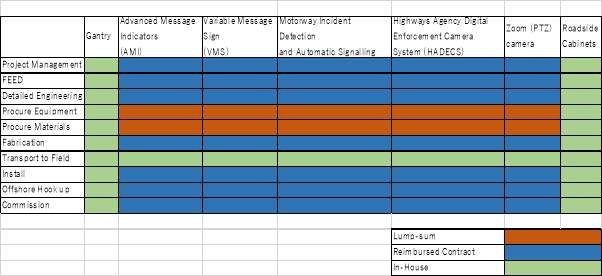
According to the Governance Chart, the China State Construction Engineering Corporation is the principle execution party. Having Considered local environment conditions and researched about this company’s capability by comparing the costs and benefits associated with producing a good or service, a recommendation is that all the project activities of Gantry, Roadside Cabinets and transportation of the field are allocated to CSCEC to be completed in house. For the rest of the project scope, a suggestion of outsourcing those to the suppliers who are more competent, professional and collaborative can help National Highway Authority to reduce the cost by the use of their human specify, tactical knowledge and core competency as a contractor, allowing to reduce the transaction cost associated with the implementation of smart motorway. Thus, two kinds of contracts can be considered to sign with the new contractors. The first one is lump-sum. Since this kind of contract form is generally predictable, easily manageable and enables JWG to avoid over expenditure, National Highway Authority could sign lump sum contract regarding to equipment and material purchase to avoid risk of cost over-run. The second kind of contract is reimbursed one. This kind of contract gives flexibility to contractors and at the same time offers the incentive to achieve more profits or further contracts based on the performance of their previous contract. For the activities which needs certain duration, such as management, fabrication and commission, reimbursed contract can facilitate the contractors’ better performance and in turn creates a win-win outcome for JWG and contractor.
Smart motorways function by adopting various operational regimes to meet scheme operational requirements including:
Controlled motorway, Hard shoulder and All Lane Running
Variable speed limits are to be maintained for all the types of smart motorways, which is the use of a obligatory speed. This is the speed to be maintained by all the motorist as it is the legal maximum speed shown on the digital signboard. Detection equipment’s are installed on strategic location throughout the smart motorway to monitor the traffic condition and lane usage. This will be the role played by National Highway Authority of Pakistan. This equipment is used to analyse the traffic data on either the traffic is causing queuing or congestion. Motorway Incident Detection and Automatic Signalling (MIDAS) system is used to open or close the extra lane also called Hard Shoulder on controlled motorway depending on the traffic condition. During the excess traffic on CPEC route the extra lane will be used when the trade cargo will have to be transported from China or to China via Pakistan. Algorithms within the MIDAS system identify traffic conditions and routinely set suitable signs and required speed limits on sign board to actively manage traffic. Safety interference, provided by the algorithm allows the protection against traffic queuing. Congestion is managed by reduced speed limits of vehicles coming from behind to increase traffic throughput. All Lanes Running strategy convert the hard shoulder into a permanent running lane and operating with all the algorithm and detection features. If in future CPEC route is widely being used by trade along all of Eurasia, then the hard shoulder can be converted to a permanent lane making smart motorway an all lane running strategy.
What type of technology is procured and why?
Message and speed signs are used to give information to the drivers on smart motorway about the road condition, lane usage, emergency refuge area and mandatory speed limit. CCTV coverage is provided throughout the route which allows for the operating mechanism of smart motorway. On CPEC, NHA will be responsible for the sustainable operation. Two types of widely used CCTV techniques are identified:
- Pan, Tilt Zoom (PTZ) CCTV Cameras provides complete coverage of the smart motorway and allow to control, monitor, operate and sustain the traffic condition on the route.
- Hard Shoulder Monitoring (HSM) Cameras provides full coverage of the hard shoulder, which allows to ensure and operate any breakdown and emergency of vehicles on refuge area. It also allows the use and control of traffic on the hard shoulder.
Vehicle detection
To understand the traffic conditions like speed and flow, the MIDAS system used helps to gather the data from strategic points on the smart motorway. The two widely used techniques are identified:
- Inductive Loops is a conventional method. They are embedded inti roads to measured variation in traffic inductance by identifying the vehicle speed and flow as it passes across them.
- Radar Vehicle Detection is used to gather the traffic parameters like volume of traffic, spacing between vehicles and gaps in traffic flow by strategically positioning them on the poles or carriageways. They help to improve complex traffic management and ongoing variations of the different parameters identified.
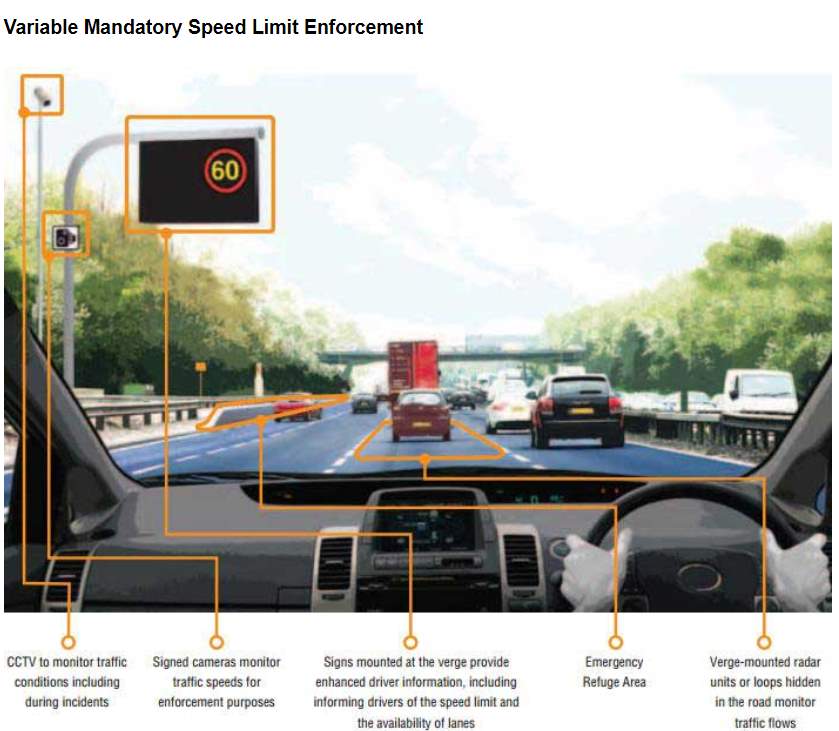
Figure 11 Smart Motorway Regulation Adapted from Designing Building (2017)
To ensure the adherence of smart motorway regulations and operational, Highways Agency Digital Enforcement Camera System (HADECS) are embedded as part of smart motorways technique. These help to control and monitor the traffic of all the lanes simultaneously. These can also adjust the threshold of the lane usage and align them with varying speed and lane usage.
Pilot Project for smart motorway
A questionnaire approach was taken to collect the responses of implementing smart motorway. The responses collected, secondary data collected and already developed motorways were then researched to find the optimal point of having the pilot project for smart motorway construction and implementation to create a sustainable operation mechanism of traffic flow.
The area of the Pilot project is chosen while keeping in mind the main route of the CPEC that connects Pakistan to China, which is the western route. The most populated province of Pakistan which is Punjab was the most important area where the problem of congestion was at peak as per the responses. The region of Punjab becomes the part of Eastern route and it is the most developed province of Pakistan. 60% of the GDP of Pakistan is coming from the areas of Punjab. This means that the usage of vehicles and road networks is the most in Punjab and it needs infrastructural development or sustainable operation mechanism.
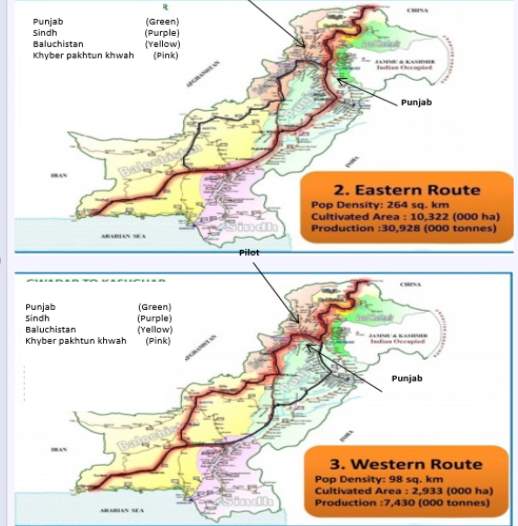
Figure 12 CPEC Route Adapted from cpec bulletin (2017)
Most of the transportation of manufactured goods for trade purpose is coming from Punjab as there are industrial zones in this province. As per the responses the respondents were about the CPEC project and mostly agreed that it is a trade route from Pakistan to China. On the other hand, they did not have much knowledge about what is a smart motorway and what are the benefits of the smart motorway. Upon clarifying the term smart motorway and highlighting the benefits of smart motorway, all the respondents were in the favour of implementing the smart motorway on CPEC route. Most of the responses were in the favour that eastern route should be used for the implementation.
Upon conducting further research into the highway projects, routes and their connectivity. One route was identified that connects the eastern rote and the western route. This was the Indus Highway. This highway has been planned to be constructed as 4–Lane Motorway as a part of CPEC, cost of the project is estimated around $ 1.1 Million. The objectives of this pilot project are:
The planned 4–Lane Motorway will largely contribute to the economic and social development of the central Punjab and south KPK while connecting the East and the West route.
It will bring more population into the stream of benefits associated with smart motorway.
Apart from time saving, this area will help in transforming the surrounding area by urban regeneration, hence uplifting the local community and regional condition. This will be because that most of the surrounding area near the pilot is under-utilised. There is not much scope for agriculture in this area so regeneration will help in creating tourist attraction and change the focus from primary sector to generating Gross Domestic Product (GDP) from service sector.
It will also contribute in ensuring a smooth and efficient undertaking of trade, and traffic in short time.
The total length of the 4–Lane Motorway is estimated as 285km. The 4–Lane Motorway is a part of the Eastern route of the CPEC. It passes from Punjab which have been identified as the most congested province by the respondents and connects the main route in province Khyber pakhtun Khwa (KPK). KPK is the other province and located on North of Pakistan with mountainous area. This highway has now been constructed is expected to boost the business activities in northern Punjab and southern KPK. The new constructed route will be a shortest and fastest facility as compared to the existing available road network. As the route already have an additional fourth lane compared to the previously constructed motorways, now this will be an optimal location for having the Pilot project of 285 km of smart motorway. As the project is to be completed by 2030, in that case the pilot project will provide a reasonable data for the smart motorways benefits and success. This data can then be used for the further road network and highways that are yet to be constructed. The pilot project will allow to distinguish any changes in the plan or budget required for a complete implementation of smart motorway throughout the metropolitan areas as part of CPEC. If the technique works based on the Key performance indicators (KPI) like journey time reduction, reduction in highway accidents, less congestion, less carbon emission, on the pilot project than the implementation on full scale for other metropolitan areas will be beneficial. The pilot project will act as a milestone for the full implementation of smart motorway to create a sustainable operation mechanism of traffic flow.
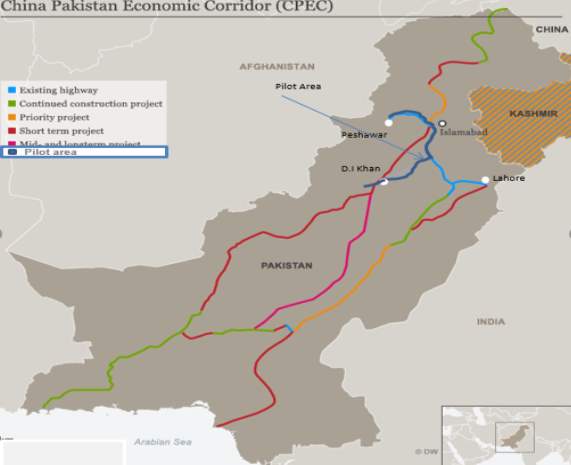
Figure 13 Pilot Area Adapted from EIA (2014)
Change Management
Technological advancements have dramatically accelerated the speed of change in the realm of construction industry. New technology, the changing needs of infrastructure, and economic pressures all contribute to the need for transport infrastructure to modify practices continually. Quality improvement (QI) of current processes is central to these efforts. Change management is any action or process taken to smoothly transition an individual or group from the current state to a future desired state of being. Key steps for successful change management include assessing readiness for change, establishing a sense of urgency, assembling the steering team, developing an implementation plan, executing a pilot, disseminating change, and anchoring the change within the organization. Adoption of change management practices increases the odds of success because focus is placed on the people in the organization who make things happen.
Coordination within construction projects
Owing to the importance of time, the need to perform and coordinate the activities sequentially, and the specialization of actors, there are tight couplings between activities undertaken on site. According to (Brockmann & Girmscheid, 2007), this is one important factor that makes construction complex. Time or duration change in any specialist’s work may affect the duration of others or even the overall production process duration. This sort of knock-on effect may also affect production cost.’ Furthermore, the activities are not only sequentially interdependent but also organized in parallel sequences, i.e. stages or elements of the construction process are overlapping. According to (Brockmann & Girmscheid, 2007) this adds to the complexity: ‘The overlapping of major elements of production is used by practitioners simply to compress or shorten the production time. In practice, this process is dictated by many resource dependent factors. Even by considering these factors, overlapping may change the interdependence of activities (or trades in particular) within individual elements and create a new structure of interdependences between the roles of the overlapping elements. These changes may increase the effects of inherent complexity and uncertainty factors on project complexity.
- ADKAR approach of change management, to learn from pilot, gain knowledge about what were the hurdles in the implementation of smart motorway to come up with new actions and strategy to reinforce the plans of smart motorway on a complete CPEC network will be a useful tool. (Awareness, Desire, Knowledge, Action, Reinforce)
The NHA and CSCEC should be aware of the organisational culture, regional culture and the increasing use of vehicles on CPEC. Desire is either there or it must be created, as the respondents came across the benefits of smart motorway there was a clear desire for such project to go on. Now only the need is for NHA and CSCEC to transfer the desire and the knowledge about the smart motorway within their respective organisation including the managers and employees. This will create an internal trust mechanism as the ADKAR approach requires the individual within an organisation to change and adapt to the current needs and situation. The internal organisational desire to thrive and adapt to new situations will allow to gain knowledge and act on how the smart motorway can be implemented and how the sustainable operation mechanism will be achieved. The model depends on the internal and individual ability to collaborate with other external and individual of another organisation, or with the general user to generate ideas for continuous improvement. The continuous improvement allows the reinforcement of the model again so inertia does not become a bottleneck in this change management model. Mistakes are identified in previous goal and corrective actions are taken. Therefore the model requires a Pilot project once the mistakes of the pilot project are identified than the corrective action for other routes to implement smart motorway techniques are can be taken. The success of change efforts is critical to improve quality of project. Adoption of change management practices increases the odds of success because focus is placed on the people in the organization who make things happen. It is also important to note that change is more readily accepted when it is viewed as a state of being rather than a onetime event. The pilot recommended above have been identified by individual research, secondary data and the view of respondents for this dissertation. The pilot project may by different depending on the Political, social, and legal requirements of the Bureaucratic institution established by government of Pakistan.
- If the pilot fails then the reason for the failure will be highlighted to improve the existing plan using the DMAIC technique. (Define, Measure, Analyse, Improve, Control)
The quality management tool is used to achieve the six sigma. Pilot project will help to highlight the and define the social problem like effect on flora and Fiona or of the deforestation when the pilot project is done. The Key performance indicators like carbon emission, traffic flow, congestion and the key risk indicators identifies in the risk section will be measured and analysed based on the defined social, environmental and economic problem. As the smart motorway depends on technological use , communication, information and data collection to statistically work out the optimal speed. The methods to improve the performance on pilot project and future smart motorway project can then be established. To improve the usage of smart motorway there can be a timing for heavy weigh vehicles to transport cargo. Most of the heavy weight vehicles in Pakistan are used for transportation while night time when the light weight vehicles are less on motorway. Same can be used to improve the problem of capacity on smart motorway if the overall trend of vehicles on smart motorway keeps on rising. Lastly the control can be of smart motorway itself or the NHA for operating the smart motorway. The DMAIC approach on Pilot will not only help to define the problems or mistakes on usage of smart motorway but it will also define the problems in NHA for organisational culture change, IT problems and communication problems that could not be identified in the planning phase.
ADKAR and DMAIC will both help in quality management of the service provided by smart motorway and the ongoing need of change required on organisational, bureaucratic, individual and economic level on an ongoing basis to achieve continuous improvement for the sustainable operation of smart motorway.
SWOT
Strength
Distance Reduction:
Currently, China uses a longer route for the international trade with the European market and American market. The route passes through the strait of Malacca and uses the water transportation system. This is a costlier route and involves a longer distance. CPEC and Gwadar deep sea port will reduce the current distance by 12000 km for China. As many power projects are involved and Gwadar smart city project is also going on the transportation from this route alone will allow Pakistan to generate a revenue by means of custom clearance and road tolls. Smart motorway will help to reduce the time of transportation in a manner that there is least possible impact to the environment by reducing carbon emission on the route.
Development of Infrastructure:
A stable economy will be created in Pakistan and re-development of many underutilised land is being used for the means of trade. It will allow an increase in standard of living by creation of better diplomatic ties. Smart motorway in that case is not only limited to the regional domain but it will also benefit the common users of Pakistan.
Improved socio-economic status:
By means of the project the socio- economic status will be developed by having better infrastructure and international relation with the central Asian and the European countries. Having the long-term objectives in front, the sustainable operation is a key as land is a limited resource and infrastructure could not be built indefinitely. With the development of smart motorway on CPEC the socio-economic status of masses of the entire region will develop.
Weakness
Indigenous Industry:
As it is known that Pakistan is an underdeveloped country the institutional bodies and the regulation bodies do not have much power and authority. China on the other hand has shown a tremendous growth in past years. The dependence on the Chinese government for the project means that the Chinese regulatory bodies are also involved. As Pakistan lacks competency in regulation it is possible that all the control of the smart motorway is looked by the Chinese regulation body. Pakistan might not be able to promote the local industry and local authorities.
Outdated Vehicles:
Smart motorway is an initiative for smoother traffic flow, lesser carbon emission and to create a sustainable operation. But the vehicles used for transportation are outdated and do cause much carbon emission even when they are on standby. An initiative of the modern vehicles being used for the transport of cargo is also required. As new vehicles is fuel efficient. Technological change on motorway is one thing but new technology vehicles are also required to enhance the total impact of the initiative. At present most of the cargo vehicles in Pakistan has outlived their life and it will be a source of problem in future
Opportunity
Means of communication:
Both Pakistan and China will be able to have a better communication in terms of trade, distance reduction and diplomatic ties. Both the countries will be benefitting with the smart motorway and the communication system setup for the trade as well as for the common people. Countries can support each other in time of need either it is regarding trade, operation of smart motorway or natural hazard which will fall into the category of uncertainty
Creation of employment:
CPEC and smart motorway will allow the regeneration and development activities hence providing an income stream for many unskilled and jobless worker as well as those skilled in project, operation, supply, logistics and IT. There is an opportunity of the creation of many training institute for training people on the operations of smart motorway.
Special economic zones:
There are going to be 27 special economic zones as per the plans of CPEC. These will create the industrial areas in many metropolitan locations. The pilot of smart motorway and the learning curve derived from the mistakes learned, as well as the change management approach described above will be an effective means to learn from pilot and create similar operation for traffic management where the industrial areas or the special economic zones are located.
Export of primary products:
Pakistan rely more on the primary sector and exports of fruits by air to many European countries. The transportation is costly because of under developed road infrastructure. Smart motorway and development in infrastructure will allow the road network transportation which is less costly for Pakistan.
Threat
Security challenge:
As the smart motorway depends on the communication system and IT any breakdown or failure in the communication or operation mechanism may lead to a severe traffic on the highway. Dependence on IT means that there will be security threat of hackers to break into the operating system to create disturbances. In such circumstances the smart motorway will have an adverse impact and regardless of dealing with the traffic management there will be a danger of ending up with more congestion and severe environmental impact from the emission from their vehicles.
Natural disaster and hazardous effect:
Earthquakes leads to cracks on the roads and land sliding in mountainous areas. This means that smart motorway on the western route which passes through the mountainous area will require a lot of rebuilding if any such incident occurs. Such events will delay the transportation, damage the roads and increase the costs. Earthquake resistant infrastructure is beneficial for the eastern route but the western route still faces the threat of land sliding. The damage of smart motorway will be costly to recover if such incident occurs.


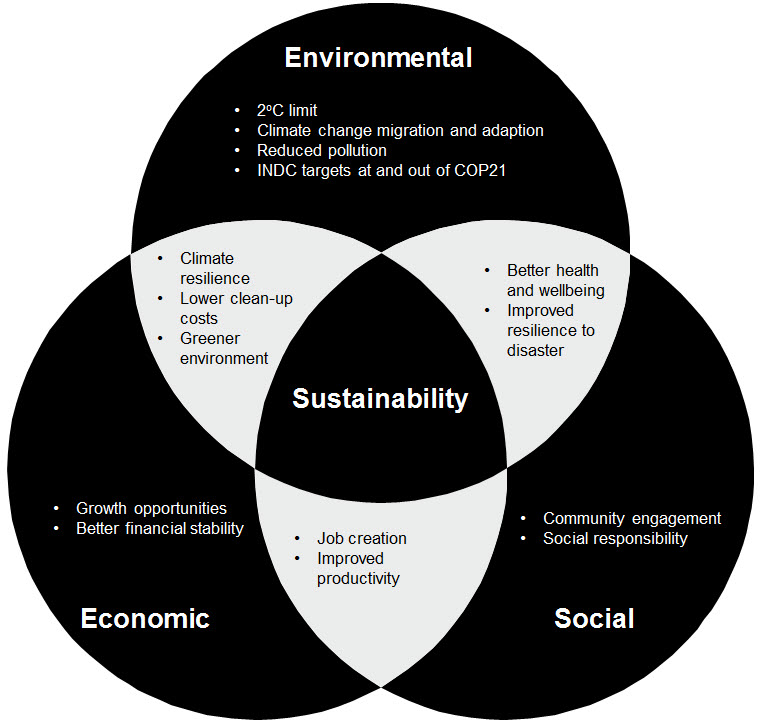
Table 11 Triple Bottom Effect of Smart Motorway on CPEC
Discussion
As far as the revolutionary breakthrough is concerned, there is a bigger picture of re-creating the silk road and CPEC is just one part of the whole vision. As far as the importance of the CPEC is considered it may be a part of a bigger plan but because of the deep-sea port in Gwadar and distance reduction it is of major importance for China and European market. Hence, smart motorway will involve many international stakeholders as the competition wiil be with the port of Chabahar (Iran), Dubai (UAE) and Oman port. Smart motorway is not the part of the original CPEC plan but from the responses collected the users are in the favour of having the smart motorway on the metropolitan areas. The respondent has significant knowledge about the CPEC and get their knowledge from electronic media and from discussion with other people. However, there was no or little knowledge about the smart motorway. The argument is that is the infrastructure more important than the education and health, and based on this it was comprehended that given the future goals of Pakistan of using CPEC as a supply network, the development of infrastructure will automatically allow for less unemployment because of the creation of jobs. It will also allow to build more training institute to provide skills for the future projects, make use of currently under-utilised land.
According to the data collected, there is the problem of congestion on highways in Pakistan because the 3-lane motorway are not able to facilitate the volume of traffic. The debate regarding the smart motorway is that because the literacy rate is low in Pakistan and regulation on traffic control is not followed properly so will the truck drivers be able to follow the instructions of the smart motorway. Most of the respondents were either neutral or against that the regulation will be followed. But still they were in favour of having smart motorway depending on the benefits of better fuel efficiency and less carbon emission. As this directly helps to reduce the problem of climate change and reduce environmental cost as per the triple bottom line concept.
From the literature of supply chain, we know that supply chain exists to deliver efficiency and to be responsive. From the operational point of view smart motorway is not just supporting individual business but economy. The pillars of operation management depend on cost, quality, speed, flexibility, innovation and dependability. Smart motorway will help to reduce transport cost, especially for the third-party logistics and fourth party logistic. The techniques use technology for innovation of traffic flow management hence providing innovation. Hard shoulder will provide the flexibility in lane usage and avoiding backlogs on highway which may become bottleneck. The whole process will improve the quality and speed of the traffic flow management and operating mechanism on CPEC route. Lastly a better infrastructure is required to cater the need of upcoming trade and vehicle usage so a sustainable operation will provide dependence on smart motorway. From supply chain perspective the smart motorway will allow efficient transport system for domestic and international trade. MIDAS system use will collect the data of vehicle to respond to the speed and lane usage. Although agile is used in responsive supply chain of manufacturing industry, the ability of the IT system of smart motorway to respond to the use of motorway will make it an agile system, as it depends on the volume of vehicles on motorway. Smart motorway provides a service of traffic management as a continuous process and is in line with the concept of sustainability and triple bottom line as it helps to reduce environmental costs and social costs. It relies on a pull system as volume of traffic is the variable that will work as a demand in this case.
A network readiness index is created below which provides a highlight of the benefits of smart motorway on CPEC, according to the secondary data collected and the responses from questionnaire.
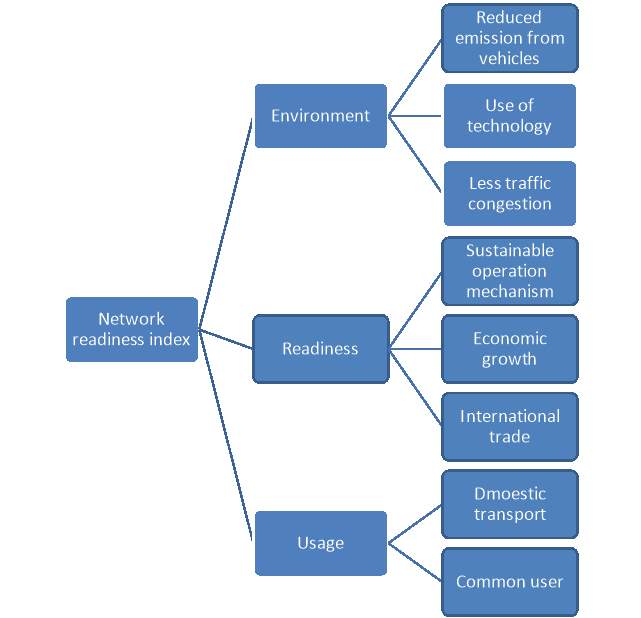
Table 12 Networked Readiness Index of Smart Motorway on CPEC
Research Importance
The motive of the research is to determine whether it will be feasible to create a sustainable operation and smart motorway, if yes than to what extent will the benefits accrue of creating a supply network through road infrastructure implementation and if no than what are the hurdles or the blockers that are being acting as a constraint. The readiness of the government and users for the smart motorway scheme and an insight into the operation service system for the future trade and developmental relationship between Pakistan and Eurasia countries that are interested in being part of the project such as Germany, Spain, Russia, Turkey, Afghanistan, Iran and China.
Academically the hypothesis tested by the research is the user preference on smart motorway and the long-term benefits accruing to have the smart motorway based on the data collected. The research also gives a brief insight on the creation of a supply network using smart motorway on CPEC nationally and internationally by incorporating a route with smoother transition. Lesser congestion, service availability for defected vehicles, response time and response rate for emergency purpose could become the key performance indicators for testing the service rate and the increase in vehicles, time taken to travel and the user satisfaction on route might be judged from the collected data by contrasting the number of users who want to go with the smart motorway idea, how often they use motorway, what are the problems they face on conventional motorways and will the users be satisfied with the plans and agenda behind the smart motorway.
The implementation has been tested through the SWOT analysis of the smart motorway technique and also some of the external factors like political, environmental, technological and economical. For such implementation, the internal and external understanding of the idea is essential for the creation of a sustainable operation. Having smooth operation, less congestion and less time to travel are one side for short term and because CPEC is such a huge mega-project the main purpose of this project will not be left in vain, which is to improve the economic condition of Pakistan by better diplomatic relationship and manufacturing capabilities for international trade.
Research Limitation
This study is limited because of the questionnaire approach using the convenience sampling method for the collection of data. The minor stakeholder who has been negatively affected by the CPEC because of land acquisition, deforestation and soil erosion may not have been the part of the respondents. As the elections were to be in Pakistan so the government employees were reluctant to provide the latest data, however the reports published in the last couple of years were used as secondary data for the highway projects going on and the institutional framework of the CPEC. Also, all direct stakeholders of this mega-project from the Chinese region with direct interest in the CPEC operating mechanism for trade and economic purpose were not included in the study, only the responses from Pakistani population was collected. The study may also be limited using a non-probability, convenience sampling method because of time constraint for the dissertation submission. Care was taken when generalizing these findings to the entire population of Pakistan but that was on the judgement basis of analysing the primary and secondary data in hand. Finally, the use of simple statistical techniques may introduce an element of subjectivity into the interpretation and analysis of the data. All attempts were made to minimize the effects of these limitations on the study by cross referencing the primary data with the secondary data and comparing the responses from survey with the information available where smart motorway have already been implemented like UK, Germany and Netherland . As at this stage the research is only based on the readiness of users and the benefits of the smart motorway techniques the data might also not be able to give a valid insight between the economic growth and betterment of trade relation with other countries at this stage. There is a further scope of the study of smart motorway for urban development; international relation and international trade as this dissertation have been researched from the perspective of sustainability, operations and supply chain for highway consruction.
Conclusion
The house-held vehicles, needs for the transportation and the readiness index developed from data suggest the current knowledge and use of highways from the sample population and their willingness for such an investment strategy which will give a huge environmental and social impact. The collaborative institutional framework will be required for the smart motorway implementation and the governing bodies to look after and control of smart motorway mechanism to align the goals of the users and the use of advanced procedures. The perceived benefits; internal and external, national and international, short-term and long-term and lastly on route benefits to vehicles and macro-economic benefits to economy of Pakistan, a recommended risk mitigation strategies and the institutional structure have been derived from the study.
Considering the knowledge of CPEC and smart motorway of the respondents, as well as from the network readiness index approach the implementation of smart motorway is much needed. Pilot project will highlight the gaps that were not considered before because of the information asymmetry. The pilot will work as a stepping stone for the full scale implementation allowing for the better and sustainable use of resources. The resilience of sustainability in construction has mostly been based on the buildings and product life cycle working towards cost of quality. A few institutions have now started working on sustainability in infrastructure and civil engineering. One of the key challenges for sustainability in infrastructure is the collection of the relevant data.
Co-operation between the fields of sustainable operation and usage of resource is much needed. Given that the current infrastructure of Pakistan is not capable of handling volume of vehicles being used nowadays, causing environmental and social problem. There is a much need, to use the resources more efficiently and effectively. The inclusion of the risk paradigm in the implementation of smart motorway on CPEC leads to a unified approach from the perspective of operations and sustainability. Considering that there is a low level of knowledge of the smart motorway among respondent but there is a need for change, when the long term benefits are kept in mind. Network readiness index does show the benefits as perceived by the respondents and that they are ready for the implementation of smart motorway techniques for a better traffic management. The research might have some limitation at this point but sustainable operations by the help of smart motorway will not only be serving Pakistan but also China and other European countries who are interested in trade by the Silk road and One Belt One Route (OBOR) initiative.
References
Alan Rushton, P. C. (2010). The handbook of logistics and distribution management (4 ed.). Great Britain: Kogan page limited.
Ashfaq, M. A. (2015). CPEC: Challenges and Opportunities for. Journal of Pakistan vision, 16(2), 142-169.
Brundtland. (1987). Our common future. United Nations.
Eddington, S. R. (2006). The Eddington transport study. Norwich: Crown.
Gil, N. (2004). BAA: The T5 Project Agreement. BAA: The T5 Project Agreement. Manchester, UK: Manchester Business School.
Highway England. (2015). Strategic business plan 2015-2020. Crown.
Ladyman. (2018, July 01). Cutting Carbon Emissions is Not Just About Cleaner Vehicles. Retrieved from from: https://www.clearview-intelligence.com/blog/cutting-carbon-emissions-is-not-justabout-cleaner-vehicles: from: https://www.clearview-intelligence.com/blog/cutting-carbon-emissions-is-not-justabout-cleaner-vehicles
P. Dadhich, A. G. (2015, June). Developing sustainable supply chains in the UK construction industry:. Developing sustainable supply chains in the UK construction industry:, pp. 271-284.
Threlfall, W. a. (2018, july 01). http://www.building.co.uk/infrastructure-smart-motorways/5080863.article . Retrieved from http://www.building.co.uk/infrastructure-smart-motorways/5080863.article : http://www.building.co.uk/infrastructure-smart-motorways/5080863.article
Varaiya, P. (1993). Smart Cars on Smart Roads:. IEEE TRANSACTIONS ON AUTOMATIC CONTROL, 38, 195-208.
Wilson, S. (2016, August 9). What are smart motorways and how do they work? Why do we need Smart Motorways?
Abid, M., & Ashfaq, A. (2015). CPEC: Challenges and Opportunities for Pakistan. Pakistan Vision, 16(2), 142–169. Retrieved from http://www.documents.pk/file/Punjab University (PU) – CPEC- Challenges and Opportunities for Pakistan.pdf
Ahi, P., & Searcy, C. (2013). A comparative literature analysis of definitions for green and sustainable supply chain management. Journal of Cleaner Production, 52, 329–341. https://doi.org/10.1016/j.jclepro.2013.02.018
Ansell, C., & Gash, A. (2008). Collaborative governance in theory and practice. Journal of Public Administration Research and Theory, 18(4), 543–571. https://doi.org/10.1093/jopart/mum032
Aoieong, R. T., Tang, S. L., & Ahmed, S. M. (2002). A process approach in measuring quality costs of construction projects: Model development. Construction Management and Economics, 20(2), 179–192. https://doi.org/10.1080/01446190110109157
Approach, S., & Measurement, S. P. (1997). A stakeholder approach to strategic performance measurement. Sloan Management Review, 38(3), 25–38.
Aqeel, M. (2016). Impact of China Pakistan Economic Corridor, 8(16546), 1244–1278.
Ashby, A., Leat, M., & Hudson-Smith, M. (2012). Making connections: A review of supply chain management and sustainability literature. Supply Chain Management, 17(5), 497–516. https://doi.org/10.1108/13598541211258573
Assessment, E. I. (2017). Feasibility Study of New Four Lane Motorway Starting from Yarak on Indus Highway N – 55 to Hakla on M – 1, (March).
Barbosa, J. A., Braganca, L., & Mateus, R. (2015). Assessment of Land Use Efficiency Using BSA Tools: Development of a New Index. JOURNAL OF URBAN PLANNING AND DEVELOPMENT, 141(2). https://doi.org/10.1061/(ASCE)UP.1943-5444.0000208
Beck, M. B., & Cummings, R. G. (1996). Wastewater infrastructure: Challenges for the sustainable city in the new millennium. Habitat International, 20(3), 405–420. https://doi.org/10.1016/0197-3975(96)00022-7
Berardi, U. (2012). Sustainability Assessment in the Construction Sector: Rating Systems and Rated Buildings. Sustainable Development, 20(6), 411–424. https://doi.org/10.1002/sd.532
Bibo, L., Yan, G., Bangding, X., Jiantong, L., & Yongding, L. (2008). A laboratory study on risk assessment of microcystin-RR in cropland. Journal of Environmental Management, 86(3), 566–574. https://doi.org/10.1016/j.jenvman.2006.12.040
Birdsall, M. (2014). ITE London study tour 2014 part two: Learning from the highways agency transformation and smart motorways. ITE Journal (Institute of Transportation Engineers), 84(12), 26–30.
Bocchini, P., Asce, M., Frangopol, D. M., Asce, D. M., Ummenhofer, T., & Zinke, T. (2014). Resilience and Sustainability of Civil Infrastructure : Toward a Unified Approach. Journal of Infrastructure Systems, 20(2), 1–16. https://doi.org/10.1061/(ASCE)IS.1943-555X.0000177.
Bocchini, P., Frangopol, D. M., Ummenhofer, T., & Zinke, T. (2014). Resilience and Sustainability of Civil Infrastructure: Toward a Unified Approach. Journal of Infrastructure Systems, 20(2), 04014004. https://doi.org/10.1061/(ASCE)IS.1943-555X.0000177
Boman, M., & Mattsson, L. (2008). A note on attitudes and knowledge concerning environmental issues in Sweden. Journal of Environmental Management, 86(3), 575–579. https://doi.org/10.1016/j.jenvman.2006.12.041
Bradford, J. B., & Hobbs, N. T. (2008). Regulating overabundant ungulate populations: An example for elk in Rocky Mountain National Park, Colorado. Journal of Environmental Management, 86(3), 520–528. https://doi.org/10.1016/j.jenvman.2006.12.005
Brady, T., Davies, A., Gann, D., & Rush, H. (2007). Learning to manage mega projects: The case of BAA and Heathrow Terminal 5. Project Perspectives, (November 2015), 32–39.
Briscoe, G., & Dainty, A. (2005). Construction supply chain integration: An elusive goal? Supply Chain Management, 10(4), 319–326. https://doi.org/10.1108/13598540510612794
Briscoe, G., & Dainty, A. (2005). Construction supply chain integration: an elusive goal? Supply Chain Management: An International Journal, 10(4), 319–326. https://doi.org/10.1108/13598540510612794
Brockmann, C., & Girmscheid, G. (2007). Complexity of Megaprojects. CIB World Building Congress, 219–230.
Brown, B. J., Hanson, M. E., Liverman, D. M., & Merideth, R. W. (1987). FORUM Global Sustainability: Toward Definition. Environmental Management, 11(6), 713–719. https://doi.org/10.1007/BF01867238
Brundtland. (1987). Our Common Future. In World Commission on Environment and Development/WCED.
Bryman, A., & Bell, E. (2003). Business Research Methods. Oxford University Press.
Burgess, K., Singh, P. J., & Koroglu, R. (2006). Supply chain management: A structured literature review and implications for future research. International Journal of Operations and Production Management, 26(7), 703–729. https://doi.org/10.1108/01443570610672202
Callaghan, N., Avery, T., & Mulville, M. (2017). “Smart” motorway innovation for achieving greater safety and hard shoulder management. Association of Researchers in Construction Management, ARCOM – 33rd Annual Conference 2017, Proceeding, (September), 745–754. Retrieved from https://www.scopus.com/inward/record.uri?eid=2-s2.0-85035339202&partnerID=40&md5=386f10b031898f34b4b53ef13e213c75
Carbonara, N., Costantino, N., Gunnigan, L., & Pellegrino, R. (2015). Risk Management in Motorway PPP Projects: Empirical-based Guidelines. Transport Reviews, 35(2), 162–182. https://doi.org/10.1080/01441647.2015.1012696
Carroll, A., & Buchholtz, A. (1996). Ethics and stakeholder management. Business and Society, 970. Retrieved from http://www.swlearning.com/pdfs/preface/0324225814_PREF.PDF
Carter, C. R., & Easton, P. L. (2011). Sustainable supply chain management: Evolution and future directions. International Journal of Physical Distribution and Logistics Management, 41(1), 46–62. https://doi.org/10.1108/09600031111101420
Carter, C. R., & Rogers, D. S. (2008). A framework of sustainable supply chain management: Moving toward new theory. International Journal of Physical Distribution and Logistics Management, 38(5), 360–387. https://doi.org/10.1108/09600030810882816
CBRD. (2018). Smart Motorways, (January). Retrieved from http://www.cbrd.co.uk/articles/smart-motorways
Chang, N. Bin. (2008). Economic and policy instrument analyses in support of the scrap tire recycling program in Taiwan. Journal of Environmental Management, 86(3), 435–450. https://doi.org/10.1016/j.jenvman.2006.12.026
Clelland, D., Labour, M. P., & Bridge, T. (2008). House of Commons The Eddington Transport Study Ora ! and written evidence, (August 2007).
Clyne, T., Worel, B., & Cole, M. (2011). Green Initiatives at MnROAD. … March 13-16, 2011, Chicago, Illinois …, 720–730. https://doi.org/10.1061/41167(398)69
Collection, D. (2017). China Pakistan Economic Corridor ( CPEC ): NAVAL POSTGRADUATE, 1–15.
Collis, J., & Hussey, R. (1997). Business Research. Macmillan (Vol. 142). https://doi.org/10.1038/142410a0
CPECResearchFInalWajidMajeedRajputMP4651641. (n.d.).
Dadhich, P., Genovese, A., Kumar, N., & Acquaye, A. (2015). Developing sustainable supply chains in the UK construction industry: A case study. International Journal of Production Economics, 164, 271–284. https://doi.org/10.1016/j.ijpe.2014.12.012
Dainty, A. R. J., Millett, S. J., Briscoe, G. H., Briscoe, G. H., & Millett, S. J. (2010). Research paper New perspectives on construction supply chain integration.
Dainty, A. R. J., Millett, S. J., Briscoe, G. H., Briscoe, G. H., & Millett, S. J. (2010). Research paper New perspectives on construction supply chain integration.
Davis, K., Ledbetter, W. B., & Burati, J. L. (1989). Measuring Design and Construction Quality Costs. Journal of Construction Engineering and Management, 115(3), 385–400. https://doi.org/10.1061/(ASCE)0733-9364(1989)115:3(385)
De Teresa, J. M., Fernandez-Pacheco, A., Cordoba, R., & Ibarra, M. R. (2008). Transport properties of IBID and EBID Pt nanodeposits. 2nd International Workshop on Focused Electron-Beam-Induced Processing (FEBIP 2008).
Delmas, M., & Toffel, M. W. (2004). Stakeholders and environmental management practices: An institutional framework. Business Strategy and the Environment, 13(4), 209–222. https://doi.org/10.1002/bse.409
Ding, G. K. C. (2008). Sustainable construction-The role of environmental assessment tools. Journal of Environmental Management, 86(3), 451–464. https://doi.org/10.1016/j.jenvman.2006.12.025
Docherty, I., & Mackie, P. (2010). Planning for transport in the wake of Stern and Eddington. Regional Studies. https://doi.org/10.1080/00343400902736550
Donaldson, T., & Preston, L. E. (1995). The stakeholder theory of the corporation. The Academy of Management Review, (1), 65–91. https://doi.org/10.5465/AMR.1995.9503271992
Dong, D., Duan, H., Mao, R., Song, Q., Zuo, J., Zhu, J., … Liu, G. (2018). Towards a low carbon transition of urban public transport in megacities: A case study of Shenzhen, China. Resources, Conservation and Recycling, 134, 149–155. https://doi.org/10.1016/j.resconrec.2018.03.011
Dubois, A., & Gadde, L. E. (2002). The construction industry as a loosely coupled system: Implications for productivity and innovation. Construction Management and Economics, 20(7), 621–631. https://doi.org/10.1080/01446190210163543
Easterby-Smith, M., Thorpe, R., & Lowe, A. (2002). Management Research: An Introduction. Management Research. An Introduction. https://doi.org/10.1177/1744987107081254
EEA. (2007). Transport and environment: on the way to a new common transport policy TERM 2006: indicators tracking transport and environment in the European Union. EEA Report 1/2007.
Express, T. F. (2017). Uighur Islamic State fighters vow blood will ” flow in rivers ” in China, 2–4.
Fawcett, S. E., Magnan, G. M., & McCarter, M. W. (2008). Benefits, barriers, and bridges to effective supply chain management. Supply Chain Management, 13(1), 35–48. https://doi.org/10.1108/13598540810850300
Fernández-Sánchez, G., & Rodríguez-López, F. (2010). A methodology to identify sustainability indicators in construction project management—Application to infrastructure projects in Spain. Ecological Indicators, 10(6), 1193–1201. https://doi.org/10.1016/j.ecolind.2010.04.009
For, F. R. (2016). Highways England ’ s Supply Chain Capability, (February).
Freeman, E. R. (1984). Strategic Management: A Stakeholder Approach. Analysis (Vol. 1). https://doi.org/10.2139/ssrn.263511
Freeman, E. R. (1984). Strategic management: A stakeholder approach. Advances in Strategic Management, 1(1), 31–60. https://doi.org/10.2139/ssrn.263511
Freeman, R. E. (1984). Strategic Management: A Stakeholder Approach. Management (Vol. 1). https://doi.org/10.2139/ssrn.263511
Freeman, R. E., & Mc Vea, J. (2001). A Stakeholder Approach to Strategic Management. A Stakeholder Approach to Strategic Management, (1–2), 32.
Frooman, J. (1999). Stakeholder Influence Strategies of New, 24(2), 191–205.
Gatto, A. M. (2017). Sustainability : Is it a Well Defined Concept ? Published by : Wiley on behalf of the Ecological Society of America Stable, 5(4), 1181–1183.
Giannis, A., Gidarakos, E., & Skouta, A. (2008). Transport of cadmium and assessment of phytotoxicity after electrokinetic remediation. Journal of Environmental Management, 86(3), 535–544. https://doi.org/10.1016/j.jenvman.2006.12.003
Gill, A., Allan, C., & Carolina, N. (n.d.). Management.
Gold, S., Seuring, S., & Beske, P. (2010). Sustainable supply chain management and inter-organizational resources: A literature review. Corporate Social Responsibility and Environmental Management, 17(4), 230–245. https://doi.org/10.1002/csr.207
Golini, R., Longoni, A., & Cagliano, R. (2014). Developing sustainability in global manufacturing networks: The role of site competence on sustainability performance. International Journal of Production Economics, 147(PART B), 448–459. https://doi.org/10.1016/j.ijpe.2013.06.010
González-Benito, J., & González-Benito, Ó. (2006). The role of stakeholder pressure and managerial values in the implementation of environmental logistics practices. International Journal of Production Research, 44(7), 1353–1373. https://doi.org/10.1080/00207540500435199
Greenwood, R. (2008). Sustainable Construction, Maintenance and Operations Task Element 2 – Summary of Sustainable Construction Review By C4S at TRL Limited and Halcrow, 404(387).
Grierson, D. (2009). Towards sustainable building design. World, (September), 15–18. Retrieved from http://strathprints.strath.ac.uk/14222/
Gualandris, J., Klassen, R. D., Vachon, S., & Kalchschmidt, M. (2015). Sustainable evaluation and verification in supply chains: Aligning and leveraging accountability to stakeholders. Journal of Operations Management, 38, 1–13. https://doi.org/10.1016/j.jom.2015.06.002
Guo, F., Chang-Richards, Y., Wilkinson, S., & Li, T. C. (2014). Effects of project governance structures on the management of risks in major infrastructure projects: A comparative analysis. International Journal of Project Management, 32(5), 815–826. https://doi.org/10.1016/j.ijproman.2013.10.001
Haider, M. (2013). Economic development plan: A “vision” that may turn into a nightmare. Retrieved from http://dawn.com/news/1037321/economic-development-plan-a-vision-that-may-turn-into-a-nightmare
Håkanson, L., & Bryhn, A. C. (2008). Goals and remedial strategies for water quality and wildlife management in a coastal lagoon-A case-study of Ringkøbing Fjord, Denmark. Journal of Environmental Management, 86(3), 498–519. https://doi.org/10.1016/j.jenvman.2006.12.006
Hall, M., & Tomkins, C. (2001). A cost of quality analysis of building project: Towards a complete methodology for design and build. Construction Management and Economics, 19(7), 727–740. https://doi.org/10.1080/01446190110066146
Hamzah, A. R. (1993). Capturing the Cost of Quality Failures in Civil Engineering. International Journal of Quality & Reliability Management, 10(3). https://doi.org/10.1108/02656719310037956
Handfield, R. B., & Nichols, E. L. (1999). Introduction to supply chain management. Managing the Global Supply Chain (Vol. 35). https://doi.org/10.1080/095372899232812
Handfield, R., Sroufe, R., & Walton, S. (2005). Integrating environmental management and supply chain strategies. Business Strategy and the Environment, 14(1), 1–19. https://doi.org/10.1002/bse.422
Handfield, R., Walton, S. V., Sroufe, R., & Melnyk, S. A. (2002). Applying environmental criteria to supplier assessment: A study in the application of the Analytical Hierarchy Process. European Journal of Operational Research, 141(1), 70–87. https://doi.org/10.1016/S0377-2217(01)00261-2
Hansson, K., Danielson, M., & Ekenberg, L. (2008). A framework for evaluation of flood management strategies. Journal of Environmental Management, 86(3), 465–480. https://doi.org/10.1016/j.jenvman.2006.12.037
Hartmann, J., & Moeller, S. (2014). Chain liability in multitier supply chains? Responsibility attributions for unsustainable supplier behavior. Journal of Operations Management, 32(5), 281–294. https://doi.org/10.1016/j.jom.2014.01.005
Hassan, S. T. (2018). A Logistics Perspective on China Pakistan Economic Corridor. Retrieved from https://www.cust.edu.pk/ms_thesis/UploadedFiles/Syed Tanvir Hassan-MEM143002.pdf
Hassini, E., Surti, C., & Searcy, C. (2012). A literature review and a case study of sustainable supply chains with a focus on metrics. International Journal of Production Economics, 140(1), 69–82. https://doi.org/10.1016/j.ijpe.2012.01.042
Henriques I., S. P. (1999). The Relationship between Environmental Commitment and Managerial Perceptions of Stakeholder Importance. The Academy of Management Journal, 42(1), 87–99. https://doi.org/10.2307/256876
Herrero-Beaumont, G., & Rovati, L. C. (2006). Use of crystalline glucosamine sulfate in osteoarthritis. Future Rheumatology, 1, 397–414. https://doi.org/10.2217/17460816.1.4.397
Highways Agency. (2010). Smart motorways. Highways Agency.
Highways England. (2017). Design Manual for Roads and Bridges.
Hillson, D. (2002). Extending the risk process to manage opportunities. International Journal of Project Management, 20(3), 235–240. https://doi.org/10.1016/S0263-7863(01)00074-6
Hohenstein, N.-O., Feisel, E., Hartmann, E., & Giunipero, L. (2015). International Journal of Physical Distribution & Logistics Management Article information : International Journal of Physical Distribution & Logistics Management, 45(1/2), 90–117. https://doi.org/10.1108/IJPDLM-08-2014-0215
Hoonakker, P., Carayon, P., & Loushine, T. (2010). Barriers and benefits of quality management in the construction industry: An empirical study. Total Quality Management & Business Excellence, 21(9), 953–969. https://doi.org/10.1080/14783363.2010.487673
Hophmayer-Tokich, S., & Kliot, N. (2008). Inter-municipal cooperation for wastewater treatment: Case studies from Israel. Journal of Environmental Management, 86(3), 554–565. https://doi.org/10.1016/j.jenvman.2006.12.015
How Pakistanis perceive China-Pakistan Economic Corridor ( CPEC )? (2016), (November).
Hsu, A., Eskafi, F., Sachs, S., & Varaiya, P. (1993). Protocol design for an automated highway system. Discrete Event Dynamic Systems, 2(3–4), 183–206. https://doi.org/10.1007/BF01797158
Huq, F. A., Chowdhury, I. N., & Klassen, R. D. (2016). Social management capabilities of multinational buying firms and their emerging market suppliers: An exploratory study of the clothing industry. Journal of Operations Management, 46, 19–37. https://doi.org/10.1016/j.jom.2016.07.005
Huq, F. A., Stevenson, M., & Zorzini, M. (2014). Social sustainability in developing country suppliersAn exploratory study in the ready made garments industry of Bangladesh. International Journal of Operations & Production Management, 34(4), 610–638. Retrieved from 10.1108/IJOPM-10-2012-0467%5Cnhttp://search.ebscohost.com/login.aspx?direct=true&db=bth&AN=95891672&lang=es&site=ehost-live
Hussain, M., Ilyas, M., Mahmood, K., & Awais, A. (2017). Pragmatic Reality of China Pakistan Economic Corridor : Impacts on Economy and Logistics Industry of Pakistan. Science International.
Hussain, M., Mehmood, S., & Saeed, N. (2017). SWOT Analysis of the China- Pakistan Economic Corridor ( CPEC ). 0P *% # KGL = F ? F ; M BAE -A ? KGQ RGS ? FBGK, (January).
Ila, John, T., & Mentzer. (2008). International Journal of Physical Distribution & Logistics Management. International Journal of Physical Distribution & Logistics Management The International Journal of Logistics Management Iss Supply Chain Management: An International Journal, 38(2), 120–141. https://doi.org/10.1108/09600035199500001
IPCC. (n.d.). Summary for Policymakers Summary for Policymakers, Note 2.
Jafari, A., & Rodchua, S. (2014). Survey research on quality costs and problems in the construction environment. Total Quality Management and Business Excellence, 25(3–4), 222–234. https://doi.org/10.1080/14783363.2013.824715
Johnson, P., & Duberley, J. (2000). Understanding management research – An introduction to epistemology. SAGE Publications. https://doi.org/10.4135/9780857020185
Juran, J. M. (1988). Quality Control Handbook. 5th Ed McGrawHill 1998. https://doi.org/10.1177/004057368303900411
Kajitvichyanukul, P., Lu, M. C., & Jamroensan, A. (2008). Formaldehyde degradation in the presence of methanol by photo-Fenton process. Journal of Environmental Management, 86(3), 545–553. https://doi.org/10.1016/j.jenvman.2006.12.016
Kazaz, A. ., Birgonul, M. T. ., & Ulubeyli, S. . (2005). Cost-based analysis of quality in developing countries: A case study of building projects. Building and Environment, 40(10), 1356–1365. https://doi.org/10.1016/j.buildenv.2004.11.010
Klair, A. A., & Highways, N. (2017). Trends , Patterns and Causes of Road Accidents on N-5 , North-3 , Pakistan : a Decade Study … Trends , Patterns and Causes of Road Accidents on N-5 , North-3 : a Decade Study ( 2006-2015 ), (March).
Kleindorfer, P. R., Singhal, K., & Van Wassenhove, L. N. (2005). Sustainable operations management [Electronic Version]. Production & Operations Management, 14(4), 482–492.
Lee, S. Y., & Klassen, R. D. (2008). Drivers and enablers that foster environmental management capabilities in small- and medium-sized suppliers in supply chains. Production and Operations Management, 17(6), 573–586. https://doi.org/10.3401/poms.1080.0063
Lee, W. L. (2012). Benchmarking energy use of building environmental assessment schemes. Energy and Buildings, 45, 326–334. https://doi.org/10.1016/j.enbuild.2011.11.024
Leva, M. C., Balfe, N., McAleer, B., & Rocke, M. (2017). Risk registers: Structuring data collection to develop risk intelligence. Safety Science, 100, 143–156. https://doi.org/10.1016/j.ssci.2017.05.009
Lupisek, A., Vaculikova, M., Mancik, S., Hodkova, J., & Ruzicka, J. (2015). Design strategies for low embodied carbon and low embodied energy buildings: principles and examples. Sustainability in Energy and Buildings: Proceedings of the 7th International Conference Seb-15, 83, 147–156. https://doi.org/10.1016/j.egypro.2015.12.205
Malhotra, N. K., & Birks, D. F. (2006). Marketing Research: An Applied Approach. Financial Times Prentice Hall.
Malik, H. Y. (2012). Strategic Importance of Gwadar Port. Journal of Political Studies, 19(2), 57–69.
Maloni, M. J., & Brown, M. E. (2006). Corporate social responsibility in the supply chain: An application in the food industry. Journal of Business Ethics, 68(1), 35–52. https://doi.org/10.1007/s10551-006-9038-0
Martina, M. (2013). China premier-designate says pollution solution “long-term process.” Reuters. Retrieved from https://uk.reuters.com/article/china-pollution/china-premier-designate-says-pollution-solution-long-term-process-idUKL4N0AK5E920130115
Mentzer, J. T., DeWitt, W., Keebler, J. S., Min, S., Nix, N. W., Smith, C. D., & Zacharia, Z. G. (2001). Defining Supply Chain Management. Journal of Business Logistics, 22(2), 1–25. https://doi.org/10.1002/j.2158-1592.2001.tb00001.x
Mitchell, R. K., Wood, D. J., & Agle, B. (1997). Toward a Theory of Stakeholder Identification and Salience. Academy of Management Review, 22(4), 853–886. https://doi.org/10.5465/AMR.1997.9711022105
Montgomery, R., Hirsch, A., & Schirmer, H. J. (2015). ENVIRONMENT AND NATURAL RESOURCES GLOBAL PRACTICE DISCUSSION PAPER 02 Improving environmental sustainability in road projects (World Bank ) WORLD BANK GROUP REPORT NUMBER 93903-LAC, (93903), 1–102. Retrieved from http://documents.worldbank.org/curated/en/2015/02/23990347/improving-environmental-sustainability-road-projects
Müller, R., Turner, R., Andersen, E. S., Shao, J., & Kvalnes, Ø. (2014). Ethics, trust, and governance in temporary organizations. Project Management Journal, 45(4), 39–54. https://doi.org/10.1002/pmj.21432
Nastasi, B. K., Hitchcock, J. H., & Brown, L. M. (2010). An inclusive framework for conceptualizing mixed methods design typologies: Moving toward fully integrated synergistic research models. SAGE Handbook of Mixed Methods in Social and Behavioral Research. https://doi.org/10.1017/CBO9781107415324.004
Ogawa, M. J. (2017). Monitoring and Evaluation of Smart Motorway Schemes, (January). Retrieved from https://eprints.soton.ac.uk/413955/1/Final_e_thesis_for_e_prints_OGAWA_22957103.pdf
Olusegun, A. (2002). Selecting a quantitative or qualitative research methodology : An experience. Educational Research Quartely, 26(1998), 1–2.
Organisation for Economic Co-Operation and Development (OECD). (2004). OECD Principles of Corporate Governance. Corporate Governance in Japan: From the Viewpoints of Management, Accounting, and the Market. https://doi.org/10.1007/978-4-431-30920-8_10
Pagell, M., & Wu, Z. H. (2009). Building a more complete theory of sustainable supply chain management using case studies of 10 exemplars. Journal of Supply Chain Management, 45(2), 37–56. https://doi.org/10.1111/j.1745-493X.2009.03162.x
Parikka-Alhola, K., & Nissinen, A. (2012). Environmental impacts of transport as award criteria in public road construction procurement. International Journal of Construction Management, 12(2), 35–49. https://doi.org/10.1080/15623599.2012.10773189
Paskistan Today. (2018). PEDO, ADB ink agreement for 300 MW hydropower project | Pakistan Today. Retrieved from https://www.pakistantoday.com.pk/2018/04/24/pedo-adb-ink-agreement-for-300-mw-hydropower-project/
Policy, E. R. (2016). Mp r a, (74924).
Porter, M. E., & Kramer, M. R. (2011). The Big Idea: Creating Shared Value. Harvard Business Review, 89(1), 62–77. https://doi.org/10.2469/dig.v41.n1.28
PREBLE, J. F. (2005). Toward a Comprehensive Model of Stakeholder Management. Business and Society Review, 110(4), 407–431. https://doi.org/10.1111/j.0045-3609.2005.00023.x
Project Management Institute. (2013). A Guide to the Project Management Body of Knowledge. Drug Discovery Today (Vol. 39). https://doi.org/10.1002/9781118107249.ch2
RealismasaStanceforMixedMethodsResearchfinal. (n.d.).
Repository, I. (n.d.). Developing accident-speed relationships using a new modelling approach Developing Accident-Speed Relationships Using a New Modelling Approach by A Doctoral Thesis Submitted in partial fulfillment of the requirements for the award of Doctor of Philosophy o.
Reuter, C., Goebel, P., & Foerstl, K. (2012). The impact of stakeholder orientation on sustainability and cost prevalence in supplier selection decisions. Journal of Purchasing and Supply Management, 18(4), 270–281. https://doi.org/10.1016/j.pursup.2012.06.004
Robson, C. (2011). Real world research: a resource for Users of Social Research Methods in Applied Settings. Colin Robson (Vol. 2nd). Retrieved from http://books.google.com/books?id=DkplMcAysFQC%5Cnhttp://media.matthewsbooks.com.s3.amazonaws.com/documents/tocwork/063/9780631213055.pdf
Rushton, A., Croucher, P., & Baker, P. (2010). The handbook of logistics and distribution management. Project Management Journal (Vol. 40). Retrieved from http://www.amazon.com/dp/0749446692
Samaranayake, P. (2005). A conceptual framework for supply chain management: a structural integration. Supply Chain Management: An International Journal, 10(1), 47–59. https://doi.org/10.1108/13598540510578379
Satyawali, Y., & Balakrishnan, M. (2008). Wastewater treatment in molasses-based alcohol distilleries for COD and color removal: A review. Journal of Environmental Management, 86(3), 481–497. https://doi.org/10.1016/j.jenvman.2006.12.024
Saunders, M., Lewis, P., & Thornhill, A. (2008). Research Methods for Business Students. Research methods for business students. https://doi.org/10.1007/s13398-014-0173-7.2
Sekaran, U., & Bougie, R. (2016). Research Methods for Business: A Skill Building Approach. In Research methods for business (p. 436).
Seuring, S., & Müller, M. (2008). From a literature review to a conceptual framework for sustainable supply chain management. Journal of Cleaner Production, 16(15), 1699–1710. https://doi.org/10.1016/j.jclepro.2008.04.020
Shah, A. R. (2017). How Does China-Pakistan Economic Corridor Show the Limitations of China’s “One Belt One Road” Model. Asia and the Pacific Policy Studies. https://doi.org/10.1002/app5.224
Shah, A. R. (2017). How Does China-Pakistan Economic Corridor Show the Limitations of China’s “One Belt One Road” Model. Asia and the Pacific Policy Studies, 5(2), 378–385. https://doi.org/10.1002/app5.224
Solér, C., Bergström, K., & Shanahan, H. (2010). Green supply chains and the missing link between environmental information and practice. Business Strategy & the Environment (John Wiley & Sons, Inc), 19(1), 14–25. https://doi.org/10.1002/bse.655
Starik, M. (1995). Should trees have managerial standing? Toward stakeholder status for non-human nature. Journal of Business Ethics, 14(3), 207–217. https://doi.org/10.1007/BF00881435
Starik, M., & Rands, G. P. (1995). Weaving an Integrated Web: Multilevel and Multisystem Perspectives of Ecologically Sustainable Organizations. Academy of Management Review, 20(4), 908–935. https://doi.org/10.5465/AMR.1995.9512280025
Stavins, R. N., Wagner, A. F., & Wagner, G. (2003). Interpreting sustainability in economic terms: Dynamic efficiency plus intergenerational equity. Economics Letters, 79(3), 339–343. https://doi.org/10.1016/S0165-1765(03)00036-3
Stevens, G. C., & Johnson, M. (2016). Integrating the Supply Chain … 25 years on. International Journal of Physical Distribution and Logistics Management, 46(1), 19–42. https://doi.org/10.1108/IJPDLM-07-2015-0175
Strand, R., & Freeman, R. E. (2015). Scandinavian Cooperative Advantage: The Theory and Practice of Stakeholder Engagement in Scandinavia. Journal of Business Ethics, 127(1), 65–85. https://doi.org/10.1007/s10551-013-1792-1
SZITAR, M., GRECEA, D., & VERONESCU, O. (2012). POLICIES AND STRATEGIES TO IMPROVE THE ENVIRONMENTAL PERFORMANCE OF RESIDENTIAL BUILDINGS MADE OF PREFABRICATED PANELS IN ROMANIA. In 12th International Multidisciplinary Scientific GeoConference SGEM 2012 (Vol. 5, pp. 1143–1150). https://doi.org/10.5593/SGEM2012/S24.V5011
THE EFFECT of ORGANIZATIONAL MEMORY on ORGANIZATIONAL RESISTANCE to CHANGE : A RESEARCH on the CONSTRUCTION SECTOR in. (2018), (May).
Tsoi, J. (2010). Stakeholders’ perceptions and future scenarios to improve corporate social responsibility in Hong Kong and Mainland China. Journal of Business Ethics, 91(3), 391–404. https://doi.org/10.1007/s10551-009-0091-3
van Vuren, T., Baker, J., Ogawa, J., Cooke, D., & Unwin, P. (2012). Managed Motorways. Transportation Research Record: Journal of the Transportation Research Board, 2278(1), 85–94. https://doi.org/10.3141/2278-10
Varkey, P., & Antonio, K. (2010). Change management for effective quality improvement: A primer. American Journal of Medical Quality, 25(4), 268–273. https://doi.org/10.1177/1062860610361625
Varma, S., Wadhwa, S., & Deshmukh, S. G. (2006). Implementing supply chain management in a firm: Issues and remedies. Asia Pacific Journal of Marketing and Logistics, 18(3), 223–243. https://doi.org/10.1108/13555850610675670
Vaughan-nichols, S. J. (n.d.). Developing the, 19–21.
Wang, F. Y., Zeng, D., & Yang, L. (2006). Smart cars on smart roads: An IEEE intelligent transportation systems society update. IEEE Pervasive Computing, 5(4), 68–69. https://doi.org/10.1109/MPRV.2006.84
Wang, Z. P., Han, X. G., & Li, L. H. (2008). Effects of grassland conversion to croplands on soil organic carbon in the temperate Inner Mongolia. Journal of Environmental Management, 86(3), 529–534. https://doi.org/10.1016/j.jenvman.2006.12.004
Wang, Z., Lim, B., & Kamardeen, I. (n.d.). Change Management Research in Construction: A Critical Review. Conference.Net.Au. Retrieved from http://www.conference.net.au/cibwbc13/papers/cibwbc2013_submission_217.pdf
Williamson, O. E., The, S., Perspectives, E., & Summer, N. (2002). The Theory of the Firm as Governance Structure : From Choice to Contract. Journal of Economic Perspectives, 16(3), 171–195. https://doi.org/10.1257/089533002760278776
Wilson, W. W. (2017). Economic Inquiry 2016 Editor’s Report. Economic Inquiry, 55(4), 2031–2037. https://doi.org/10.1111/ecin.12495
Winfried, R., Roland, M. P., Alexander, D., & Jürgen, L. K. (2008). Usability of food industry waste oils as fuel for diesel engines. Journal of Environmental Management, 86(3), 427–434. https://doi.org/10.1016/j.jenvman.2006.12.042
Wu, Z., & Pagell, M. (2011). Balancing priorities: Decision-making in sustainable supply chain management. Journal of Operations Management, 29(6), 577–590. https://doi.org/10.1016/j.jom.2010.10.001
Xiao Fang. (2015). The Belt and Road initiative: connecting China and Central Europe. International Issues and Slovak Foreign Policy Affairs, XXIV(3), 3–14.
Yang, C. C. (2008). Improving the definition and quantification of quality costs. Total Quality Management and Business Excellence, 19(3), 175–191. https://doi.org/10.1080/14783360701600563
Yao, H., Shen, L., Tan, Y., & Hao, J. (2011). Simulating the impacts of policy scenarios on the sustainability performance of infrastructure projects. Automation in Construction, 20(8), 1060–1069. https://doi.org/10.1016/j.autcon.2011.04.007
Yousaf, M. H. (2014). Role of Transportation Infrastructure in Promoting Economic Development: A case of Pakistan, (June), 1–158. https://doi.org/10.13140/2.1.3228.3847
Zeb, R. (2012). Pakistan-China relations: Where they go from here? UNISCI Discussion Papers, (29), 45–58.
Zeng, L. (2016). Conceptual analysis of China’s Belt and Road initiative: A Road towards a regional community of common destiny. Chinese Journal of International Law, 15(3), 517–541. https://doi.org/10.1093/chinesejil/jmw021
Zorzini, M., Hendry, L. C., Huq, F. A., & Stevenson, M. (2015). Socially responsible sourcing: Reviewing the literature and its use of theory. International Journal of Operations and Production Management. https://doi.org/10.1108/IJOPM-07-2013-0355
Cite This Work
To export a reference to this article please select a referencing stye below:
Related Services
View allRelated Content
All TagsContent relating to: "Transportation"
Transportation refers to the process of goods, people or animals being moved from one place to another. There are multiple methods of transport, including train, boat, bus, plane, lorry, and more.
Related Articles
DMCA / Removal Request
If you are the original writer of this dissertation and no longer wish to have your work published on the UKDiss.com website then please:




